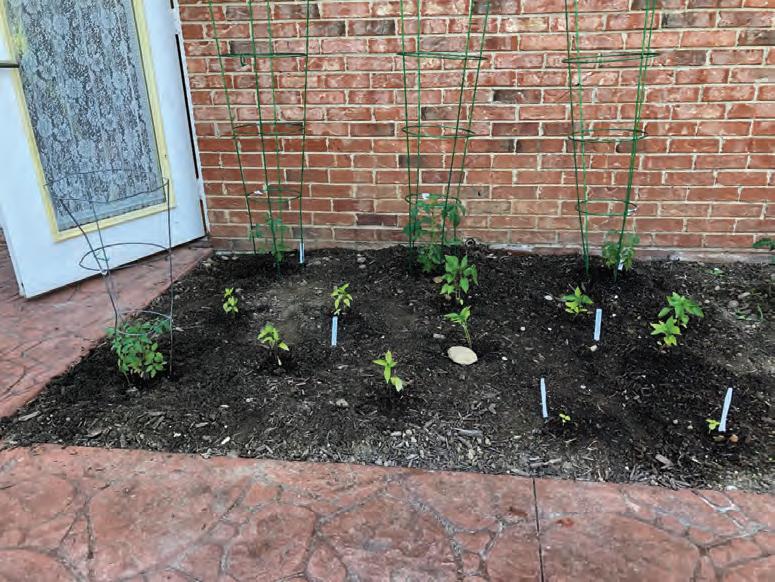UH COMMUNITY BENEFIT REPORT





• $1.2 million social impact investment to the Lead Safe Cleveland fund.
• Broke ground on the UH Glenville Community Health Center slated to open in 2023.
• Launched the first UH Caregiver Community Volunteer Time Off (VTO) program in February 2022, which currently provides 650 volunteer opportunities.
• 1,090 computers donated to PCs for People, supporting 1,382 individuals.
• 7,700 early detection screenings conducted.
• 19,500 community residents participated in health education, support groups, fitness programs or health related events.
• 7,154 people received food via a Food for Life Market or Summer Lunch Program.
• 256 youth participated in career readiness experiences.
• 54 hired via community-focused pipeline programs.
Maternal & Child Health
• 14,000 baby items distributed to young families.
• 7,600 children received pediatric dental care via the mobile unit.
• 7,000 individuals screened for social needs and 46% of the needs were met.
• 1,188 families helped by medical legal partnership services.
• 310 women participated in CenteringPregnancy resulting in an 8% pre-term birth rate and a 6% low birth weight (2021), much lower than overall county outcomes.
Dear Friend,
For more than 156 years, University Hospitals has compassionately cared for our Northeast Ohio community. Our founders committed that in establishing our great institution, “The most needy should be considered the most worthy." Just as we have cured disease and innovated new standards of care over the decades, we have also steadfastly worked to address social determinants of health and the root causes of health inequities.
We are proud of the $531 million we invested in the community in 2021 and $3.5 billion over the last decade, but we know we can and must do more.
Because innovation is in our DNA, and we know narrowing the health care disparity gap improves a community’s quality of life, we re-engineered the way we think about investments in our community. In fact, we made it a major component of our strategic plan.
Our industry is constantly challenged to do more with less, as payer reimbursements continue to trail the cost of care. We asked ourselves, what can we do differently so we have the ability to grow investment in our mission and our community, have a more meaningful impact where needs are greatest, while at the same time, advancing our focus on health equity.
First, we determined we can be much more strategically focused about how we approach sponsorships by centralizing our decision-making and having one front door. Second, we wanted to make sure those investments could really have an impact and that they align with our values and priority needs as defined by our Community Health Needs Assessments, which are conducted every three years. And importantly, we saw an opportunity to leverage the power of our more than 30,000 caregivers in a way that not only makes an impact in the community, but also facilitates team-building among our caregivers.
These initial steps sparked the development of a community health investment strategy that leverages three pillars and five focus areas.
• Anchor & Social Venture Investment provides us the opportunity to make place-based investments with large-scale impact designed to improve community conditions and address social determinants of health.
• Social Service Investment is where we partner with organizations and agencies outside of UH to engage with our patients and community
• Regional Community Health Investment involves the more traditional concept where our community hospitals and ambulatory centers provide various programming for health and wellness.
Our five focus areas include Workforce Development, Anchor Strategies, Well-being & Safety, Food Security and Maternal & Child Health.
On the following pages we illustrate some of the activities already under way in these areas.
As an anchor institution, we are humbled by our unique responsibility to influence population health and advance economic opportunities for our communities. We’ve made great strides in contributing to the health and welfare of Northeast Ohioans, and now as the Hometown Team, we are building on this legacy through our implementation of a thoughtful, bi-directional, data-driven strategy that allocates resources where needs are greatest. In doing so, we can have a more significant impact on our mission – To Heal. To Teach. To Discover. At the same time, we enhance partnerships with our community, better promote health equity and wellness, and maximize health care value.
To move the needle forward, we need transformative approaches that prioritize expanding access to high-quality care, delivery outcomes, total experience and cost of care. University Hospitals has pledged to do its part to change the narrative from being providers of health care to being promoters and agents of health equity.
The community is our patient. The community is our collaborative partner. The community is UH.
Thank you for allowing UH to be your Hometown Team.
CLIFF A. MEGERIAN, MD,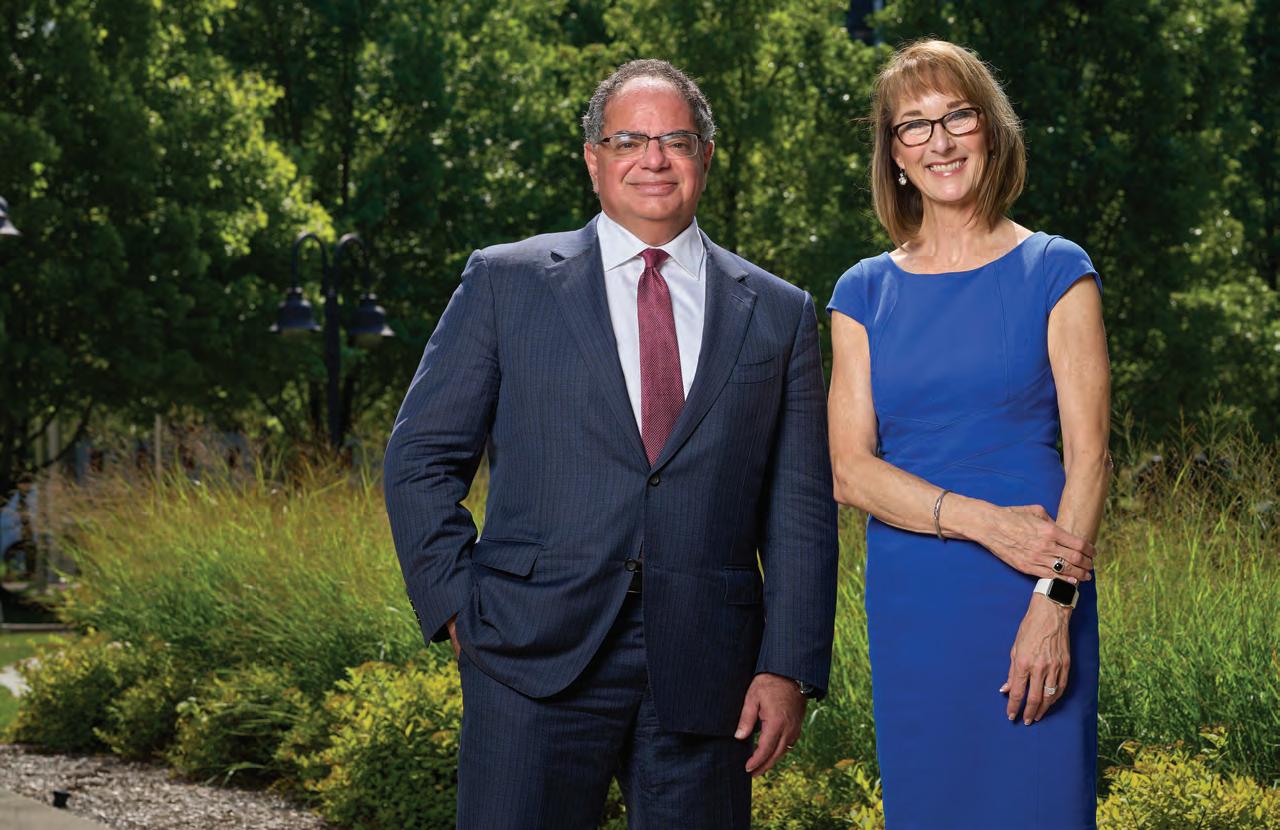
To Heal. To Teach. To Discover.
To Heal… is the care we provide to treat conditions, disease and injuries. It extends to the important work we do to prevent illness, optimize health and improve the quality of life for our patients and our community as a whole.
To Teach… refers to our role as an academic medical center in the education of the next generation of physicians and caregivers, as well as the knowledge we share with the medical community worldwide.
To Discover… signifies our commitment to applying curiosity, innovation and perseverance to medical science and clinical trials leading to new cures that extend wellness and change lives.
Advancing… speaks to our never-ending pursuit to improve the health and well-being of people here and everywhere.
Science… is how we bring knowledge to bear on healing illness, disease and injuries. Science is embodied in our dedication to research and medical best practices.
Compassion… is how we care for the spirit of our patients so they have the strength and inspiration to heal.
UH and all of our caregivers are guided in our actions and behaviors by a common set of values.
Service Excellence: We deliver the best outcomes, service and value with the highest quality through a continuous quest for excellence and seeking ways to improve the health of those who count on us.
Integrity: We have a shared commitment to do what is right and adhere to the highest standards of ethics and personal responsibility to ear n the trust of our caregivers and community
Compassion: We have genuine concern for our patients and each other while treating everyone with respect and empathy.
: We value the contributions of all caregivers, and are committed to building an inclusive, encouraging and caring culture where all can thrive.
Trust: We depend upon our caregivers’ character, reliability and judgment.
University Hospitals is the recipient of the American Hospital Association’s 2022 Quest for Quality Prize – the industry’s most prestigious honor – recognizing our commitment to advance quality and safety, address health care disparities, develop care innovations, and foster community collaboration to improve health outcomes.

1
UH’s gross community benefit investment for 2021 was $531 million. The Lake Health System became a member of the University Hospitals Health System in 2021. Included in the $531 million are the costs associated with community benefit activities provided by Lake hospitals during the full year of 2021.
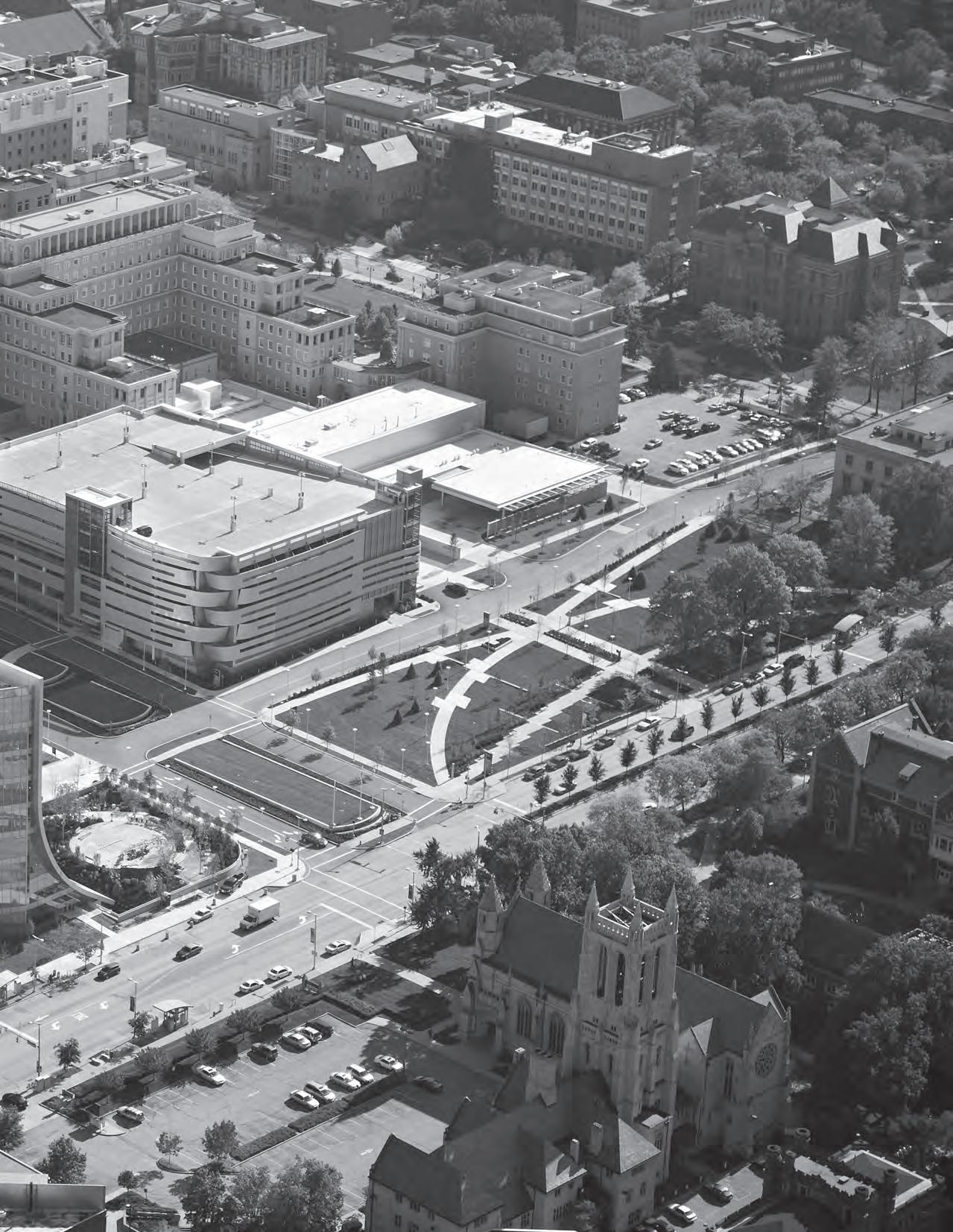
2 Under Internal Revenue Service guidelines, we subtracted $35.2 million from Medicaid Shortfall to reflect net funding recorded from the federal Hospital Care Assurance Program.
3 We subtracted $38.4 million in restricted grant funding from outside organizations from Education and Training, Research and Community Health Improvement, as required by IRS reporting guidelines for nonprofit hospitals.
Thousands more of our under-resourced neighbors now qualify for Ohio’s expanded Medicaid coverage, yet the state and federal health insurance program reimburses providers for only a portion of the care they provide. UH underwrites the remainder of these patients’ bills, reflecting our commitment to our community’s health.2
UH elevates standards of health care here and elsewhere by preparing future generations of caregivers. Approximately 1,200 physician residents and fellows train here each year, along with thousands of nurses and other health professionals. We reach into our local community to teach lifesaving techniques and to inspire people to pursue health care careers.3
UH serves our community in its broadest sense by engaging in and funding clinical research. In conjunction with Case Western Reserve University School of Medicine and privatesector health care companies, our professionals elevate care standards and develop new ways to diagnose, prevent, treat and cure diseases and injuries.3
Some of our neighbors lack the means to pay for essential health care. Throughout our history, UH has always provided care without regard to ability to pay.
Our outreach programs provide no-cost health screenings and help thousands of people understand their health, ways to improve and maintain it, and the resources available to them. We also invest in the community’s health by supporting health-related community causes.3
"I created this to show my invisible scars as a young black man, scars that I can feel but others can’t see. These scars have forced me to wear a mask that covers up the real me, the me that I want to be...I will no longer let people tell me who I am and I will no longer let the mask be who I am."
Paul Laurence Dunbar wrote the poem “We Wear the Mask” more than 120 years ago. It remains relevant, and has now inspired a movement.
Dunbar was one of the first influential Black poets in American literature, and the poem describes how people of color often suppress aspects of who they are and what they feel as a coping mechanism to navigate a predominantly white culture. It opens with the lines:
We wear the mask that grins and lies, It hides our cheeks and shades our eyes, This debt we pay to human guile; With torn and bleeding hearts we smile,
Today, We Wear the Mask is the title of a community-building movement in Cleveland designed to foster healing and shift perspectives on racial equity. It was conceived by Healthy Neighborhoods, part of the Cleveland Department of Public Health’s Healthy Cleveland Initiative.
Done in partnership with Graffiti HeArt and other community stakeholders, it uses the Make-ArtTalk-Race (MATR) community engagement practice, developed by Neighborhood Connections, a small grants and community-building organization of The Cleveland Foundation.
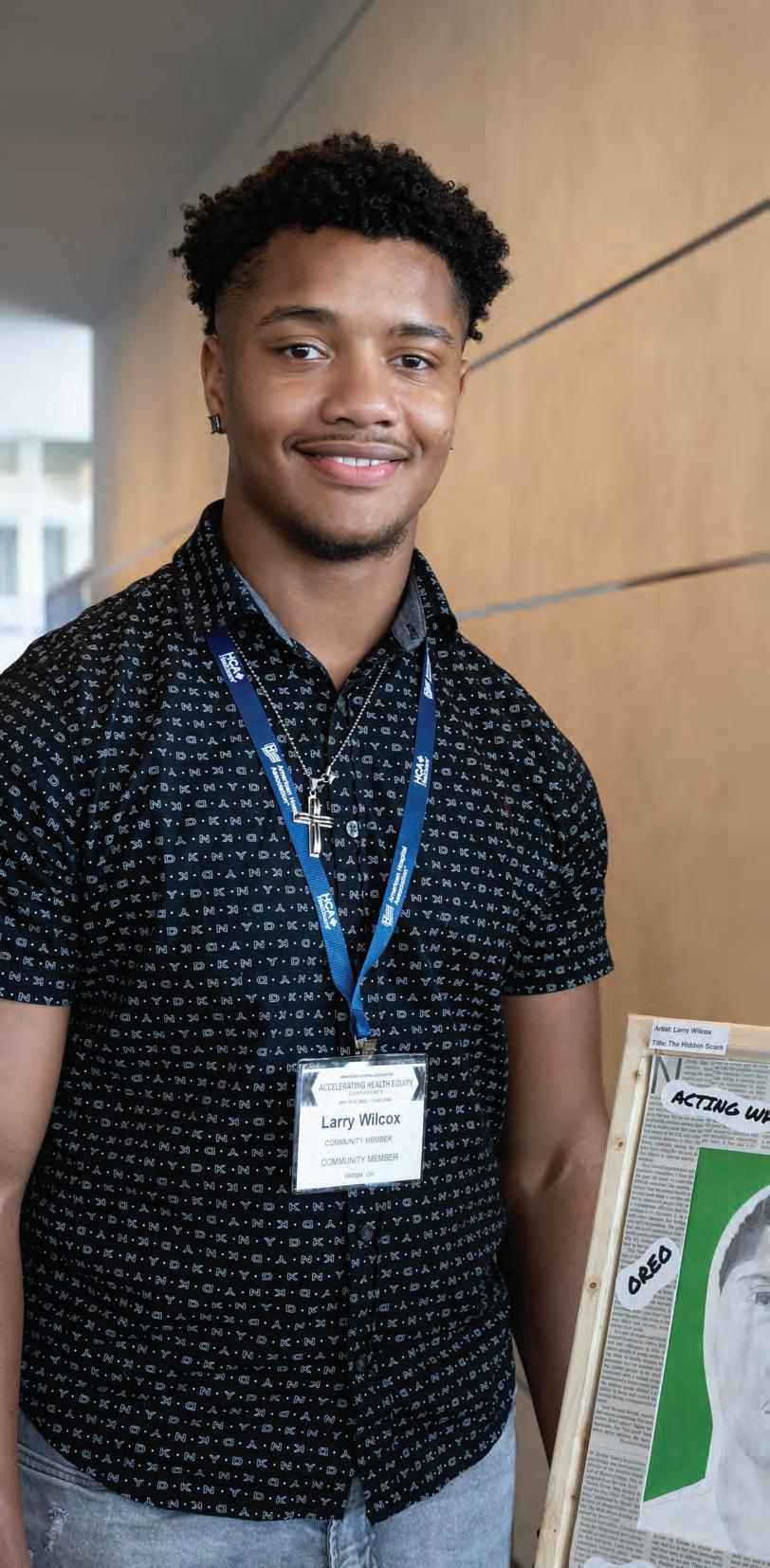
A team of University Hospitals caregivers are an integral part of the “We Wear the Mask” movement and helped co-chair this effort, which is designed to engage the community through art and dialogue. This movement demonstrates the importance of partnering with the community to attain health equity. Through various art-based avenues, participants were able to release emotions tied to internalized racism and produce “beauty from ashes.”
Often, there is a socialized norm for Black, Indigenous and People of Color (BIPOC) to wear a mask of conformity in a society that upholds euro-centricity as the standard. The We Wear the Mask movement elevated the voices and talents of Greater Clevelanders through an art competition,
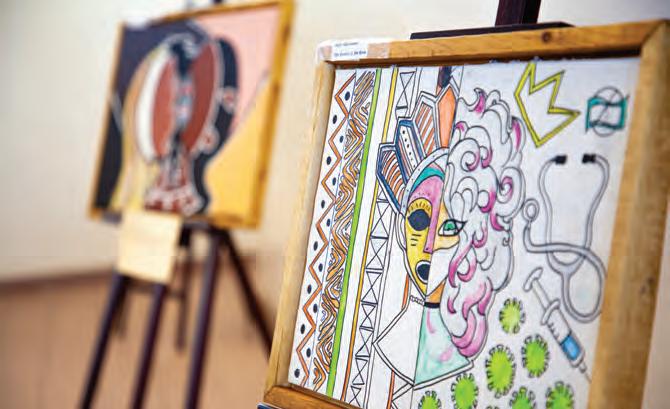


commissioning of public murals, a Masks Off video series, and in-depth radio interviews that unpacked the subject of racism.
A special We Wear the Mask event was held over the Juneteenth weekend at Morning Star Baptist Church on Cleveland’s East Side, which attracted nearly 300 people. An opening ceremony recognized local artists and community organizations, offered cultural performances by local talent, and provided a variety of indoor and outdoor family-fun activities. Minority businesses and talent were encouraged to participate.
Forty-five local artists submitted work, and 13 of them were awarded a combination of cash prizes and art exposure experiences. Their art was featured at the American Hospital Association’s Accelerating Health Equity conference, held in May at the Hilton Cleveland Downtown hotel.
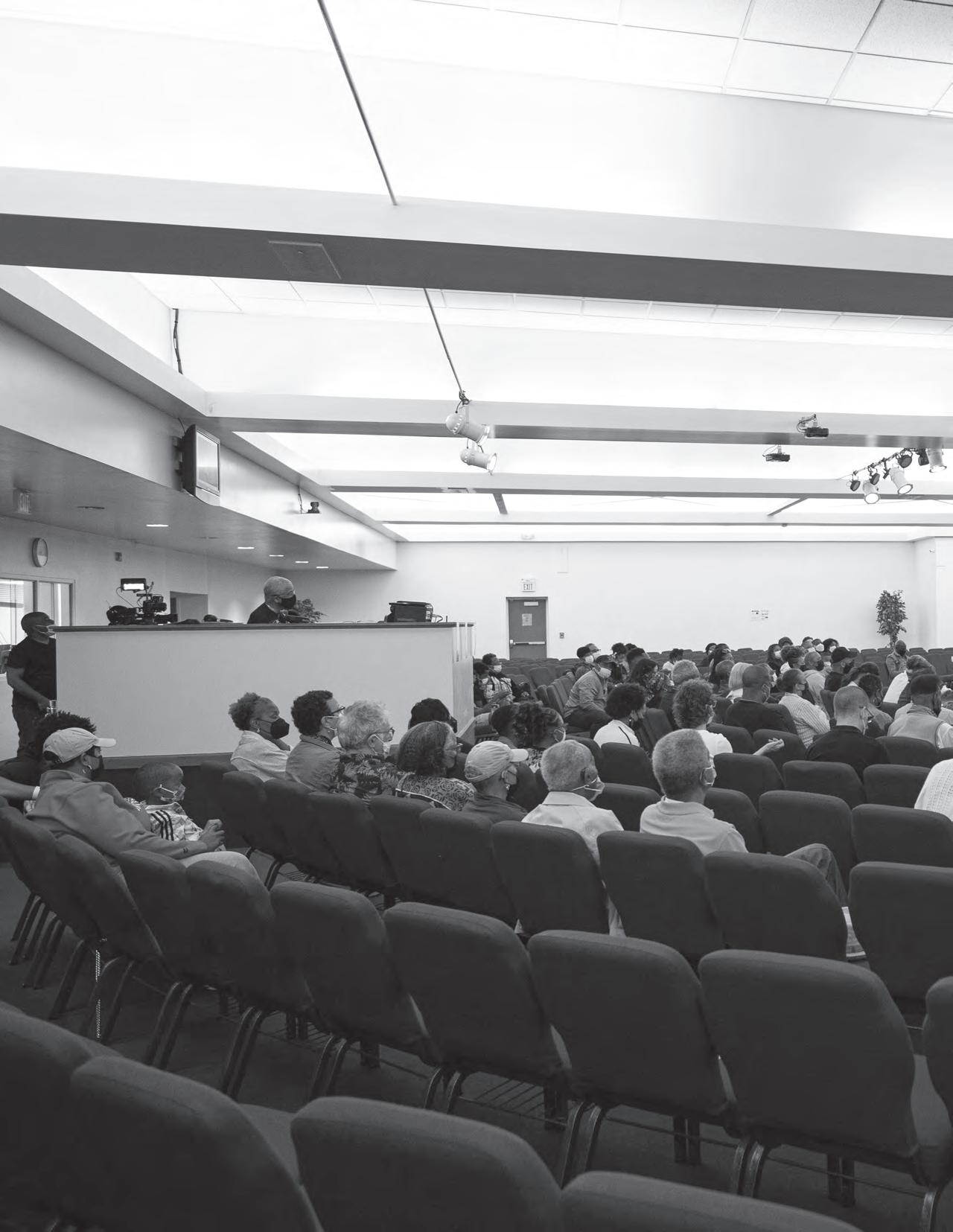
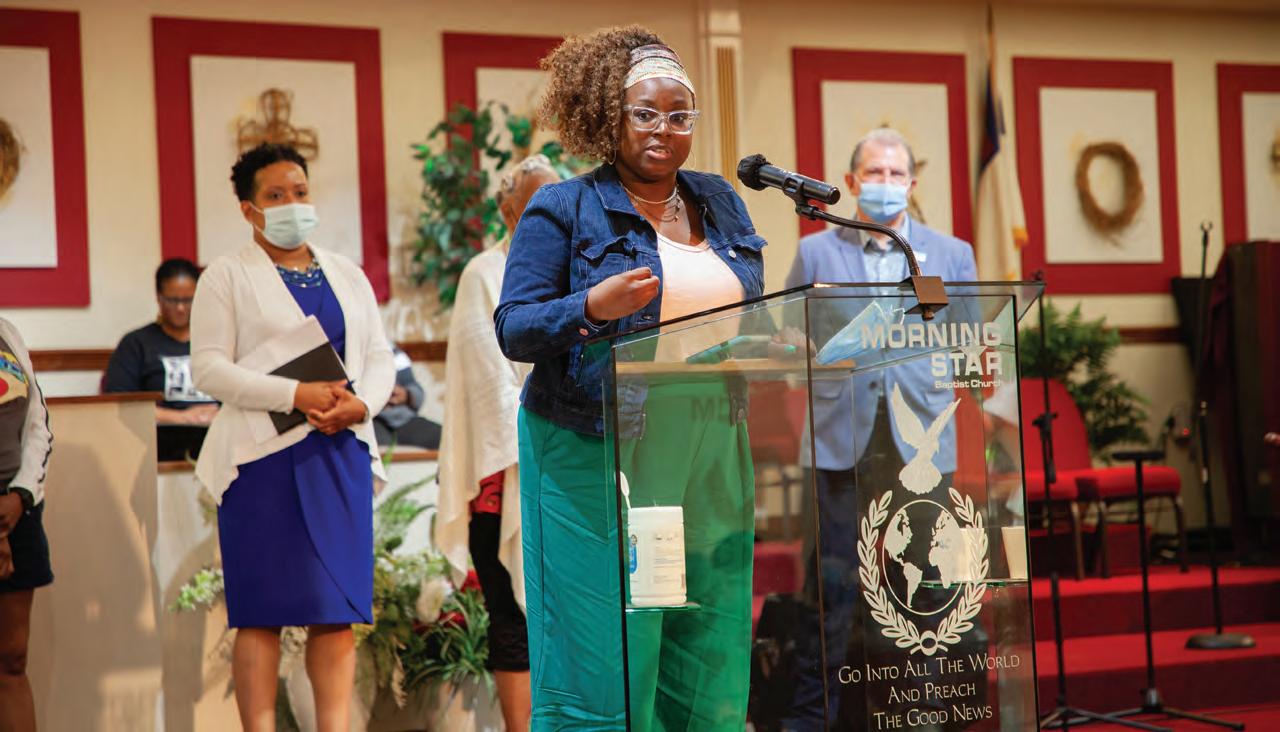
The two public murals, designed by Stina Aleah by way of Graffiti HeArt, are in MidTown Cleveland and the BuckeyeWoodhill neighborhood. The second mural, located at Woodhill and Buckeye, is the first of many planned by RTA and Elevate the East to echo community social justice themes. While the wall is often viewed as a barrier, it can become a canvas for the community. Its proximity to the Woodhill Homes Complex, with its transformation, makes it special and represents one way RTA connects to the community. The latter is the first of several commissioned works being done with Elevate the East, an initiative for spurring public art investments in Cleveland’s East Side neighborhoods.
Elevate the East is spearheaded by
City
President Blaine Griffin and Burten, Bell, Carr Development, Inc., in partnership with LAND studio – all partners in the We Wear the Mask movement. One of the murals is part of Cuyahoga Metropolitan Housing Authority’s five-year Choice Neighborhoods Buckeye-Woodhill Transformation Plan currently underway, which will lead to construction of new affordable housing.
Over the summer, the Healthy Neighborhoods committee hosted three “watch parties” using a Masks Off video series to spur discussion.
Page 11 from left to right; Top row: Cleveland Mayor Justin Bibb; Leon Caldwell, PhD, Senior Director Health Equity Strategy and Innovations at American Hospital Association; Middle row: Marilyn Burns, Woodhill Community Resident and Advocate; Mansa L. Bey; Bottom row: Laurelle and Eiden LeeGrand, both winners of the youth call for artists.
Cleveland Council




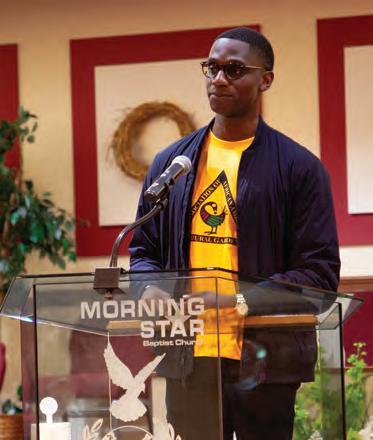
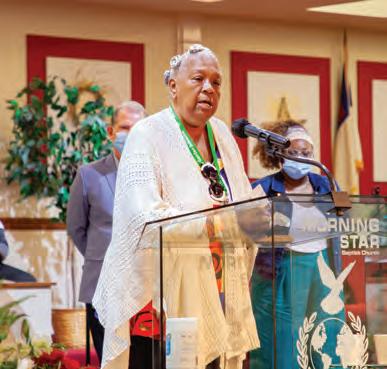 Mansa L. Bey is the 1st place winner for the professional category for his spoken word piece, "Live Vibrant in the Colors of Our Mask."
Photo by Albert Johnson (AJ) is an OEO Specialist with GCRTA.
Mansa L. Bey is the 1st place winner for the professional category for his spoken word piece, "Live Vibrant in the Colors of Our Mask."
Photo by Albert Johnson (AJ) is an OEO Specialist with GCRTA.
Lead poisoning has put thousands of Cleveland area children on a path of cognitive decline and poor school performance. Preventing lead poisoning reduces those problems and can save children in Cleveland’s neighborhoods.
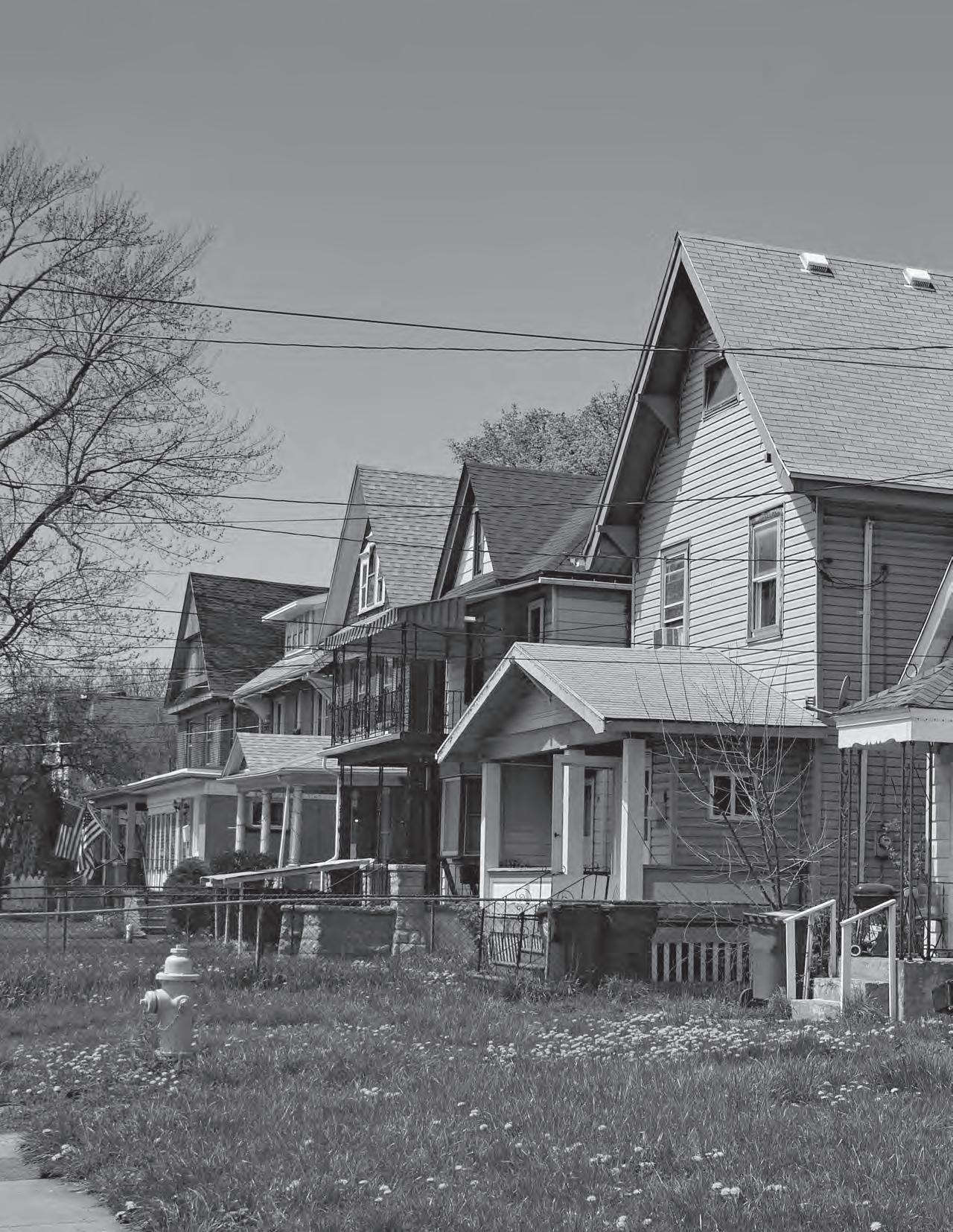

As part of its Community Health Investment Strategy to improve community conditions and population health, University Hospitals committed $1.2 million to the Lead Safe Cleveland Coalition, the publicprivate partnership that was formed to address and prevent the pernicious issue of lead poisoning.
“We are thrilled that our first action in this new mission-related investment strategy is taking a proactive step toward making Cleveland homes safe from lead poisoning," says UH CEO Cliff A. Megerian, MD, FACS.
“As an anchor institution that has been deeply rooted in this community for 156 years, we hold dearly our responsibility to care for our community. Guided by the words of our founders that ‘the most needy are the most worthy,’ our goal is to make more anchor and social investments to catalyze positive change in the region.”
As part of this new strategy, UH will take a portion of assets that would traditionally have been invested in such vehicles as stocks and bonds and make them available for investments into the under-resourced parts of Cleveland.
UH’s investment will go entirely toward the Coalition’s Lead Safe Home Fund. The Lead Safe Home Fund is a first-of-its-kind pool of resources to help families and property owners make their homes lead safe. UH’s
More than 25% of Cleveland children tested positive for lead poisoning before they entered kindergarten.
investment – along with investments from the public sector, private sector, and philanthropic partners – brings the total pool of funds to more than $115 million.
Of the total given by UH, $1 million of the investment will officially cap the Coalition’s initial $20 million loan fund, which finances low-interest loans to qualifying landlords and homeowners. The remaining $200,000 will serve as grants to property owners, lead safe worker training and/or community engagement.
Dieter Sumerauer, MD, a pediatrician at UH Rainbow Babies & Children’s Hospital and Medical Director for the Rainbow Primary Care Institute, has a special interest in childhood development and behavior and health care disparities.
“Any amount of lead is dangerous, as it interferes with our nervous system, wreaking the most havoc on the developing human brain,” says Dr. Sumerauer. Though lead can be found throughout Northeast Ohio, it is particularly concentrated in the oldest neighborhoods which many times are our most economically disadvantaged.
“While the burden of lead poisoning is particularly heavy on the individual, the cost to society is also great, with economic impact in the billions of dollars.“
As a system, UH is working to improve testing rates of all children at risk for lead exposure.
“We have introduced point of care blood sampling. This has increased the number of children who get tested for lead poisoning by decreasing the need for one more stop at the lab. The goal remains to remove lead from the community and decrease the risk of exposure - increasing the testing rate allows us to quickly act for the children with increased blood lead levels, and to understand where lead remains.
More than 90 percent of rental units in the City of Cleveland were built before 1978, which is when consumer use of lead-based paint was banned nationally.

“Because of this, many residents, especially low-income renters of color, may have trouble finding homes that are safe from lead hazards,” says Nowak.
Homeowners in Cleveland and landlords in good standing with the city’s rental registration will be eligible for loans for single family, townhome, duplex, triplex, fourplex and multifamily properties built before 1978. Loans range from $1,500 to $7,500, and other criteria apply.
A Case Western Reserve University study found that more than 25 percent of Cleveland children tested positive for lead poisoning before they entered kindergarten – and Cleveland’s lead poisoning rates are about four times the national average. The problem is even more severe in specific neighborhoods such as Glenville and Clark-Fulton, where a disproportionate number of children of color live, often in substandard housing.
“We know that most lead hazards are coming from lead dust in Cleveland homes,” says Kevin J. Nowak, Executive Director of CHN Housing Partners, administrator of the Lead Safe Home Fund loans and grants for property owners. “The dust can come from paint on windowsills, porches, or walls, as examples. We make funds available for loans to mitigate this dust, through various methods, such as a coat of paint or a technical cleaning.”
Heidi L. Gartland, Chief Government & Community Relations Officer at UH, says, “We traditionally haven’t put funding into housing, but now UH is joining several leading health systems around the nation who are beginning to do this because we have found that social and environmental factors like housing insecurity play such a large role in one’s health.
“Our strategy also calls for additional health and services investments based on community health priorities. Our investments will align with UH’s clinical and community health intervention goals and leverage the power of our health system’s more than 30,000 caregivers to make a difference through volunteerism and board service.”
“Removing lead exposure will allow our children, and consequently our communities, to thrive.”
Having a healthy heart isn’t just a matter of diet and exercise. Research shows that a person’s socioeconomic status, education, geography and environmental factors – known collectively as social determinants of health (SDoH) –contribute mightily to heart disease in the United States. This is especially true among Black people, whose rates of heart disease death are 30 percent higher than that of other groups. Further, underserved and marginalized communities have an extensive history of mistreatment by the research and medical community in the U.S., often leading to mistrust. And many times, too little is done to involve the community in the research process.
With this in mind, a collaborative team of leaders at University Hospitals Harrington Heart & Vascular Institute and Wayne State in Detroit has a new approach to care. Intentional about involving inner city Cleveland residents in every step of the research process, the team is committed to addressing health inequities.
Supported by an $18.2 million grant from the National Institutes of Health, this endeavor was dubbed “ACHIEVE GreatER." It stands for Addressing Cardiometabolic Health Inequities by Early PreVEntion in the Great LakEs Region. It involves collaboration with the community, including the
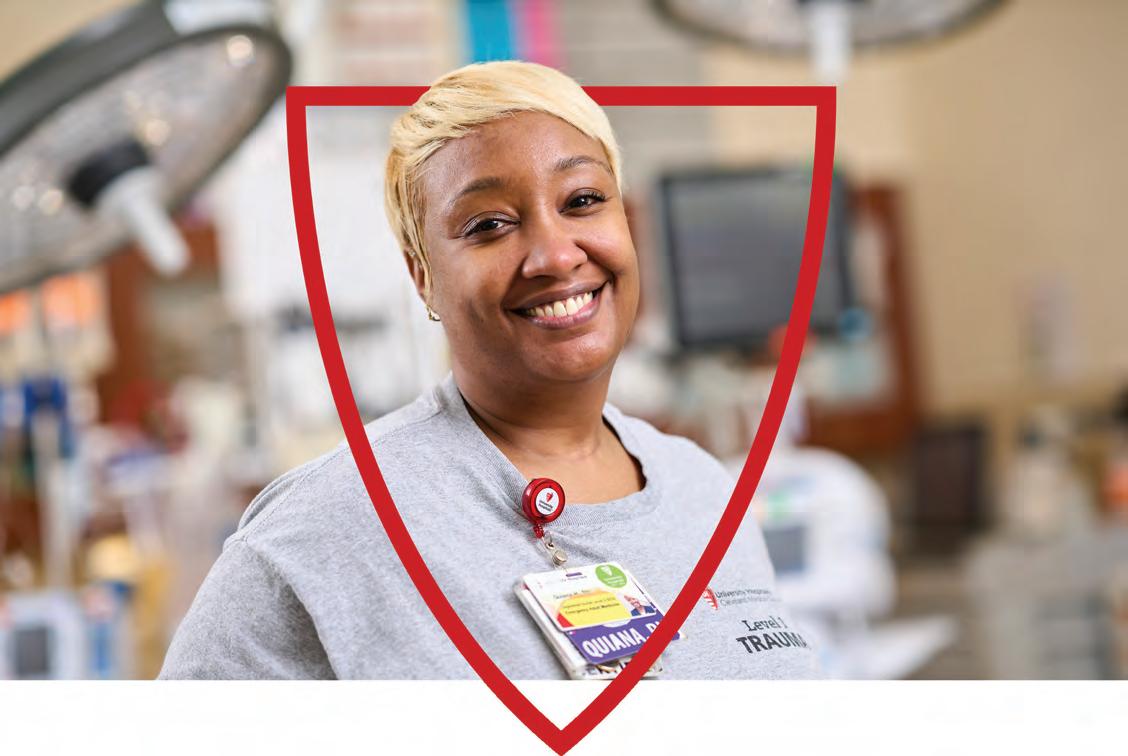
Cuyahoga Metropolitan Housing Authority (CMHA), one of the nation’s largest and oldest subsidized housing programs located in Cleveland. With this novel care delivery approach, we are going to the place that those most at high risk for heart disease live. It is funding community health workers, nurses and care coordinators to work with CMHA and provide health services, including free risk factor screening, to address social needs and improve heart health outcomes among Black community members.
Specifically, this innovative program aims to identify residents at risk of heart disease and provide personalized, adaptable approaches for engagement and prevention focused on lifestyle and life circumstances. UH and CMHA will coordinate health events across these public housing locations throughout Cleveland to identify residents with health and SDoH needs that community health workers and physicians can address together. Then residents may receive care from UH delivered with a culturally aware and personalized approach – not only medical therapies, but addressing socioeconomic, housing, hunger, workforce, safety, environmental, and psychological needs – issues that are often overlooked in health care.
Importantly, the UH team brings the research expertise to determine whether the new, personalized approach
to heart health is working. The proof will be in improved blood pressure, cholesterol levels and diabetes risk among community residents. If this new model demonstrates good results in improving heart health outcomes, it will inform how UH will change the way we practice and deliver care in the best way for our neighbors.
Leaders at UH Harrington Heart & Vascular Institute say this project is just the beginning of what they plan to do to work collectively with people in Northeast Ohio to address SDoH. UH also is collaborating on this project with the Better Health Partnership, a Cleveland-based nonprofit that will provide insights on making this novel clinical and community approach to improved heart care sustainable beyond the grant funding period of five years.
“This is the initial building block around which UH Harrington Heart & Vascular Institute plans to launch a whole range of programs that will address glaring inequities in health care in Northeast Ohio,” said Mehdi Shishehbor, DO, MPH, PhD, President of UH Harrington Heart & Vascular Institute, and Angela and James Hambrick Chair in Innovation. “As a physician caring for many of these patients in our communities, we have a fundamental duty to provide the highest level of care to each individual and address the disparities in gender, race and ethnicity.”
Sanjay Rajagopalan, MD, the Principal Investigator of the ACHIEVE GreatER Cleveland site; Chief of the Division of Cardiovascular Medicine and Chief Academic and Scientific Officer of UH Harrington Heart & Vascular Institute;
well as the Herman K. Hellerstein, MD, Chair in Cardiovascular Research.

“The ultimate goal of ACHIEVE GreatER is to reduce cardiovascular complications and hospitalizations by improving blood pressure, lipids and glucose targets for Black patients at risk of heart health issues,” said
as
HIGHER RATE OF HEART DISEASE DEATH IN AFRICAN AMERICANS
When Elizabeth Harris, PhD, was a freshman at Shaker Heights High School in 1997, an article in the school newspaper changed her life.
The story drew national attention. It focused on how, even at a school and city widely considered progressive in racial relations and believed to be providing equal opportunities to all students, the school’s own data showed a distinct gap between the academic performance of white students and Black students. One major reason seemed to be that few Black students were found in honors or advanced courses – because they weren’t encouraged or put on a track that would place them there.
“This was a pretty big deal, and of course, it created a lot of questions in my mind, mostly, 'Why is this?’” says Harris, who went on to get a Bachelor of Arts and Master of Science in psychology and a PhD in counseling psychology.
Today, she is a Minority Research Fellow at UH, and in 2020, she was honored with a three-year $75,000 grant to continue her research study, titled “Addressing Health Care Inequity through an Integrated Care Model in Pediatric Medical Settings.”
“From my freshman year in high school onward, this is what set the foundation for me to try to find out the answer to why.”

Her dissertation in college would be on the topic of academic outcomes, followed later by her PhD thesis on “Stereotype Threat, Self-Efficacy and Career Expectations in Ethnic Minority College Students.” She first joined UH as a post-doctorate fellow in 2015.
Now, she is starting with pediatrics and examining the barriers that affect the children of Black families, who are not referred to mental health treatment in the same ways that white children are by their physicians.
“This is separate research, but foundationally an outgrowth of my thesis,” she says. “What this comes down to is barriers – there is a body of research showing barriers in mental health treatment and I continue to look into that.”
Some of the barriers are not unexpected, she says, such as stigma, given the industry’s history of questionable conduct regarding medical research among Black people and ethnic minorities. “Stigma impacts one’s understanding about mental health concerns and one’s willingness to treat them, which has become an issue leading to poor overall health outcomes in youth,” she says.
“There’s healthy paranoia with regard to fear that someone will cause harm rather that help, and there’s been a culture passed down from generation to generation that you only go to the doctor when something is broken or severely wrong,” Dr. Harris adds. “And mental health concerns aren’t typically seen as major concerns.”

But sometimes the barrier to mental health services is a lack of access.
“Often parents rely on their child’s pediatricians to connect them to other services that might be necessary or available,” says Dr. Harris. “And it’s sometimes difficult for the physician to have the resources or understanding necessary to connect them with mental health services when they need them, or even to diagnose it in the moment.”
Harris sees glimmers of a shift occurring, though, and she has a growing practice that treats Black children who need mental health services.
“Pediatricians would like this to change and they have been really instrumental in working with mental health providers to do that – such as how to screen for certain conditions,” she says. “And we’d like to reach out to primary providers to do the same.
“What it also will take is meeting families where they are.”
It’s crucial for that to happen, she says, since there has been public acknowledgment that mental health outcomes in Ohio, especially in ethnic minority youth, are among the lowest in the country. That is why Gov. Mike DeWine created a Pediatric Mental Health Initiative in September 2019. That same year, Dr. Harris represented UH Rainbow at a pediatric mental health summit in Dayton, designed for participants to determine how children’s hospitals can collaborate.
UH also established the Minority Faculty Career Development Award to provide research funds to early-career faculty who are underrepresented in the field of medicine and are working to develop an independent research project. Sponsored by the UH Research & Education Institute and the Office of Community Impact, Equity, Diversity and Inclusion (CEDI), this award supports research investigators with an opportunity for career advancement. Since the award's inception, there have been nine recipients, including Dr. Harris.
“I always have my focus on what’s next, but because I’m still in the throes of the research, I know this will develop,” says Dr. Harris. "This will be what will inform our intervention and practices, so we can do a better job in addressing mental health needs for our youth.”
“There is a history of lack of trust in medical services in general that is very much alive and present and we saw that become more apparent during the pandemic.”
University Hospitals' Volunteer Time Off (VTO) program, which was announced in 2021, kicked off in 2022 with two noteworthy events.

The first was the Homeless Stand Down, held in April at First Energy Stadium, which drew about 1,000 guests and 80 UH volunteers. The guests received access to social service providers, as well as medical screenings, personal hygiene kits, bus passes and meals.
“Seeing people eager to spend time helping others is not something you often experience. I witnessed volunteers and guests connecting, sharing genuine smiles and laughter,” said Elyse Mulligan, Manager, Public Policy & Community Health Engagement at UH.
Josh Studzinski, Director of UH Strategic Marketing Initiatives, added, “I believe that when you show you truly care about people, you can make a lasting impression that may change somebody’s life for the better.”
The VTO program’s goal is to give caregivers the chance to make a difference in the communities that UH serves outside of the walls of our hospitals. UH caregivers demonstrated that commitment by volunteering at the Homeless Stand Down.
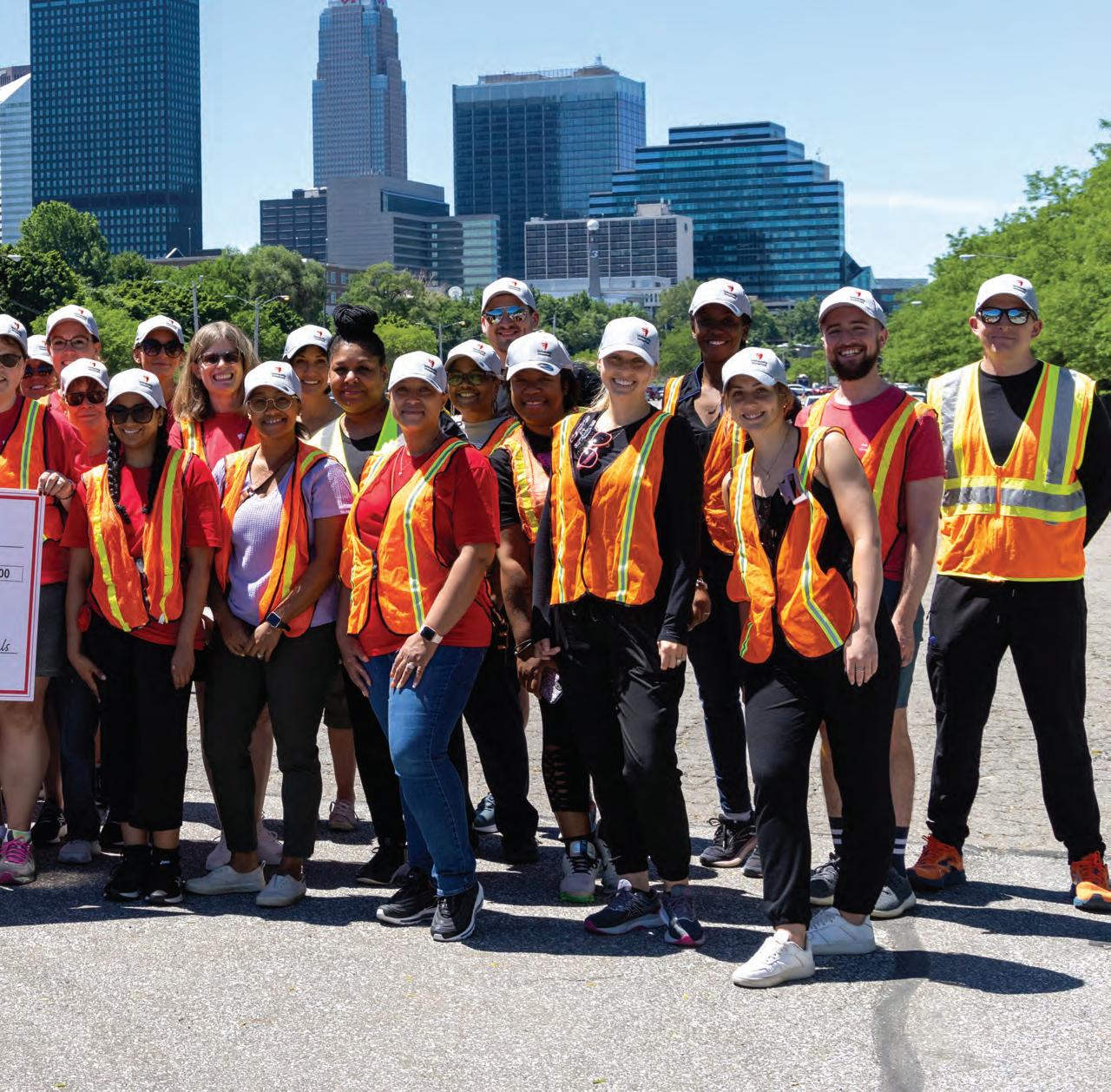
the First Energy Stadium to designate service providers and medical testing locations.
“We will volunteer again because this event was so inspiring,” Michael said.
The second opportunity for a group of UH caregivers to volunteer was in June at the Greater Cleveland Food Bank’s Emergency Food Box Distribution, a weekly event in the North Coast Municipal Parking Lot downtown.
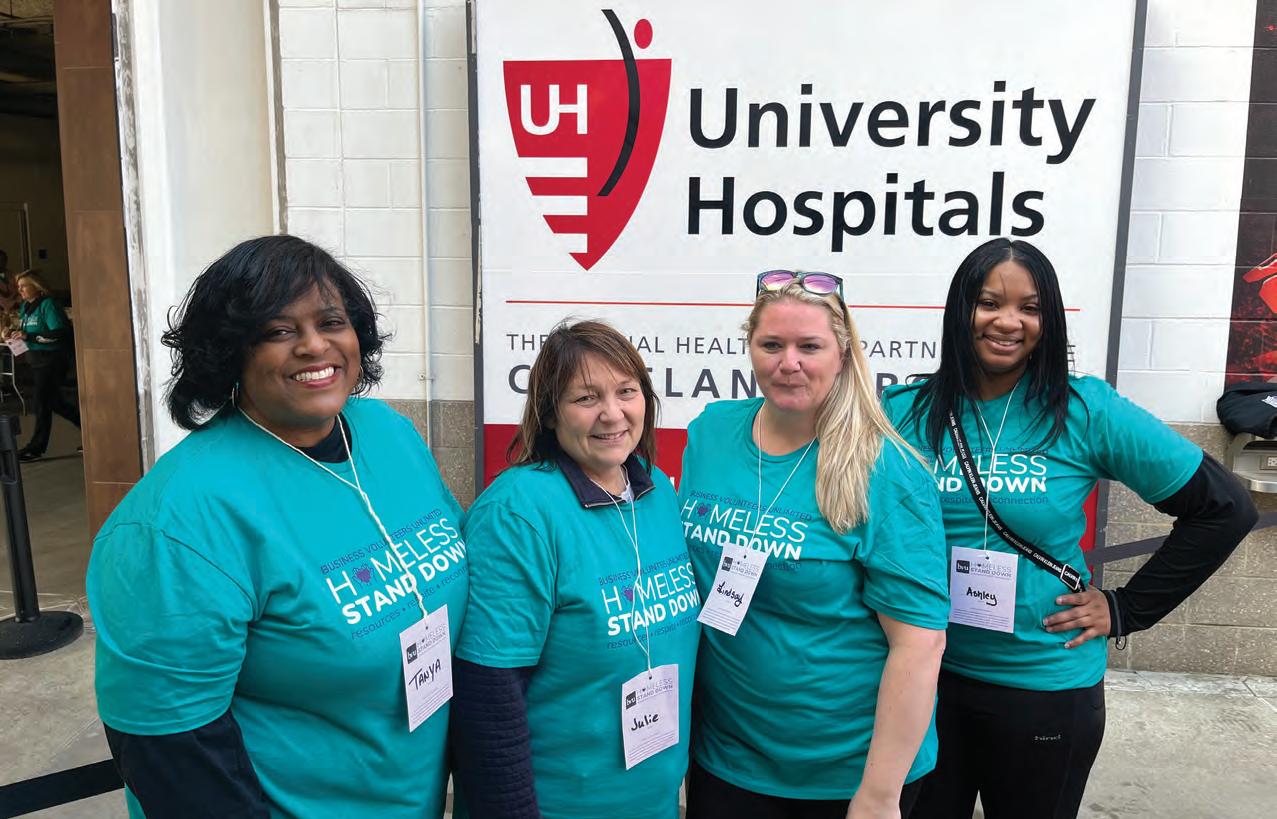
There is a direct connection between food insecurity and overall health. Food insecurity increases the probability of chronic diseases such as high blood pressure, heart disease, cancer, and diabetes. That is why addressing food insecurity is one of the five focus areas of UH’s Community Health Investment Strategy.
These weekly distributions began at the beginning of the COVID-19 pandemic, in March 2020.
“I don’t think we ever thought we’d still be here two years later,” said Karen Pozna, Director of Communications and Special Events for the Greater Cleveland Food Bank, of the Muni lot distributions. But each week, between 1,800 and 2,000 people – each representing one household – still come for shopping bags of food, which include nonperishable items, and, in summer, fresh produce.
All of them pre-register, so volunteers can be prepared for the number expected. One advantage of the drive-through pick-ups is that they are contactless – and highly-organized to be efficient, with four or five lanes of cars.
rise of inflation, and various shortages people have been experiencing. All this has definitely affected the lower-wage, middle class who live paycheck to paycheck.”
For the first 18 months, National Guard members helped with the logistics. “But then they left, and we couldn’t continue to do this without the help of volunteers,” said Pozna. “We are so grateful for partners like UH to come out and support the Food Bank in this way."

“It’s great to hear about organizations implementing an opportunity for staff to give back by volunteering. Volunteers see the relief on people’s faces, and the impact they have on people coming through here.”

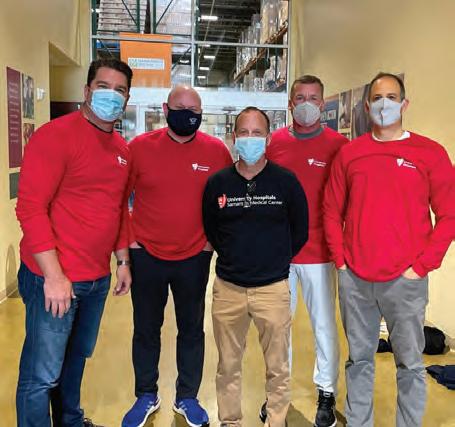
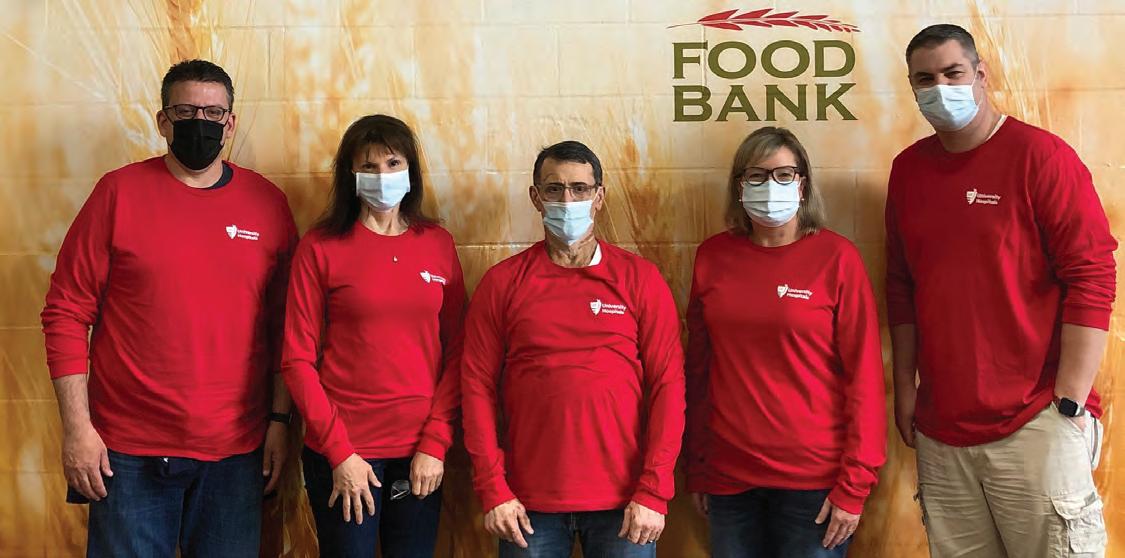
More than 130 caregivers participated in the UH Caregiver VTO program within the first 6 months.
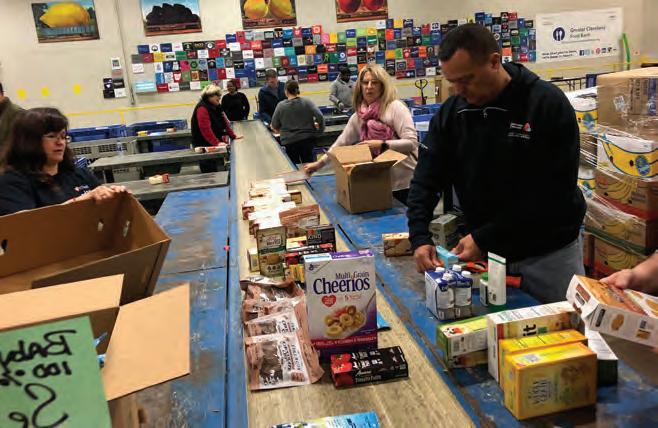


Tina Greig is a nurse practitioner in the medical ICU step-down unit at University Hospitals Seidman Cancer Center where she cares for profoundly ill patients.
Yet Tina also volunteers for various causes. It’s something she does happily several times a year, often with her two teenage girls. When she saw the first email that went out letting UH caregivers know they could take four hours of work time annually for the new VTO program, Tina was excited.
“I actually love doing volunteer stuff anyway, and I usually get my kids involved,” says Tina, who lives in Willoughby. “So I looked at the list and found Shoes and Clothes for Kids.”
The Cleveland organization has long been known for providing shoes and coats to children in need. Tina found out it does the same with school and art supplies. Many of those are donated by another Northeast Ohio company, Jo-Ann Fabrics.
That prompted Tina to sign up last spring and spend four hours at the Shoes for Kids warehouse near downtown Cleveland, which had a room filled with donated supplies. “Teachers in Cuyahoga County can shop online for what is needed in the classroom – pens, paper, notebooks and more – so my job was to go to the supply room and fill up the boxes with the orders,” she says. “There were about 50 orders I boxed.
“It was definitely a nice little break from my daily routine, getting out there to help, getting the boxes organized and filling all the orders.”
Tina and her daughters have volunteered in a number of ways – at a food bank, doing beach clean-up, and activities at their church.
“And through this opportunity at UH, I got to do something different, help an organization that I didn’t even know existed.”
Tina says she’s coming back for more volunteering at Shoes and Clothes for Kids, and she’ll bring her daughters with her.
“I think we take so much for granted,” she says. “Yet there are kids living in poverty who can’t bring these basic necessities to school, so it’s nice to provide them.
“I’ll continue to do it even without the four hours, but I’m glad that UH is also encouraging us to go out and help.”
UH’s VTO endeavor aligns with the system’s goal of connecting with the community while leveraging our caregivers’ time to benefit the health and well-being of residents in our communities.
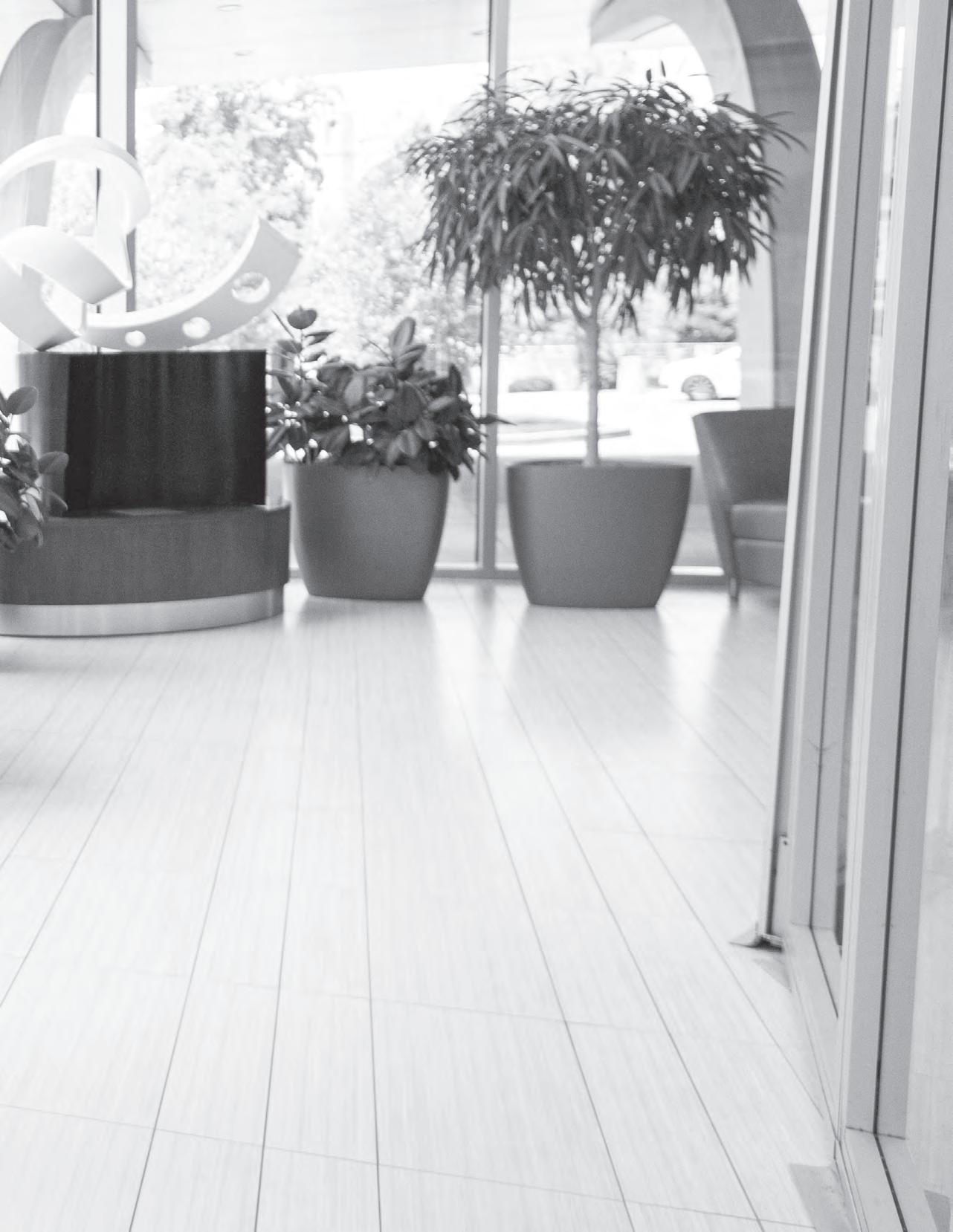

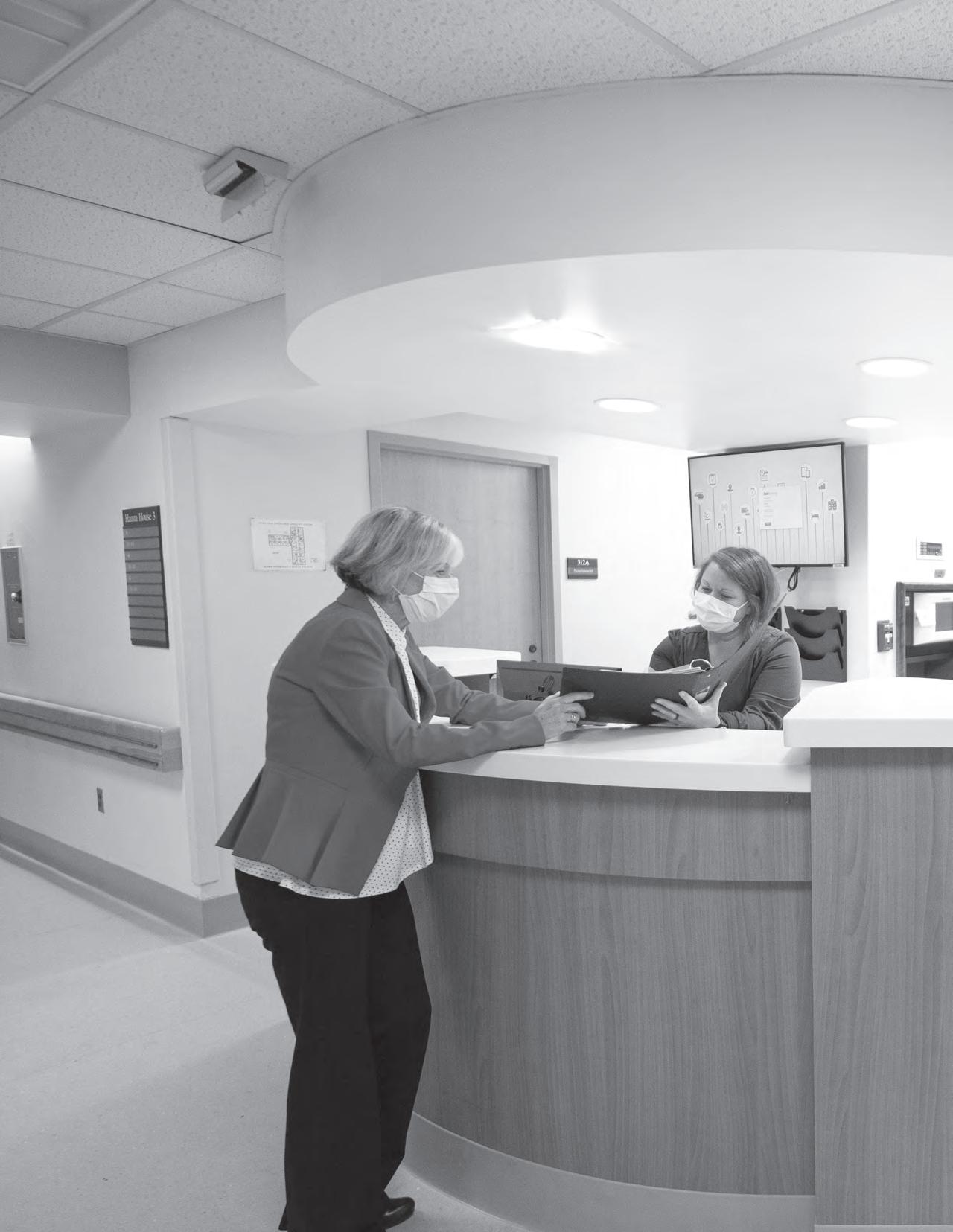
Pam Charlton works full time as the Director of Post-Acute Care and Adult Nursing Operations at University Hospitals Cleveland Medical Center.
For several years, she also has been an active volunteer at the May Dugan Center in Cleveland, but she wanted to contribute more. Five years ago, she learned that University Hospitals, through Business Volunteers Unlimited, was holding a workshop for people who wanted to become board members of nonprofit organizations.
“I was interested in doing this kind of work, and when I saw the opportunity, I signed up,” she says. “They would match you to an organization that was looking for board members, which May Dugan was. And it really helped me to learn more about what it meant to be a board member.”
She says that serving on the board of the organization has given her a wider perspective of the organization and has been extremely gratifying. May Dugan is a multi-service center that offers many social services that support wellbeing and safety, ranging from GED (high school diploma
equivalency) and English as Second Language (ESL) programs, addressing behavioral health needs, providing food and clothing, and help toward finding employment, among others.
The services that May Dugan provides dovetail perfectly with UH’s community benefit strategy – and as part of that strategy, UH encourages employees to volunteer at nonprofit or social services organizations or participate on nonprofit boards.
“Even in the five years I’ve been on the board, we’ve outgrown this building dramatically,” says Pam. “The Center is always evolving how it provides services. For example, people who rely on food donations can’t always come to pick them up during business hours. So a locker system is being purchased that will give people access to pick up food, 24/7.” Becoming a board member was a significant shift, Pam says.
“Through workshops and their education process, I got to know how their finances work,” she says, noting how crucial every dollar is at a social service agency which focuses on the needs of the community.
In the past year, the board of the May Dugan Center had five openings. “And the decision was made very deliberately to make the board more diverse,” says Pam. “We looked at the needs – for example, having someone with a finance background, another person with marketing skills, someone who works in health care,” she says. “And three of our new board members live in the community where we are located.
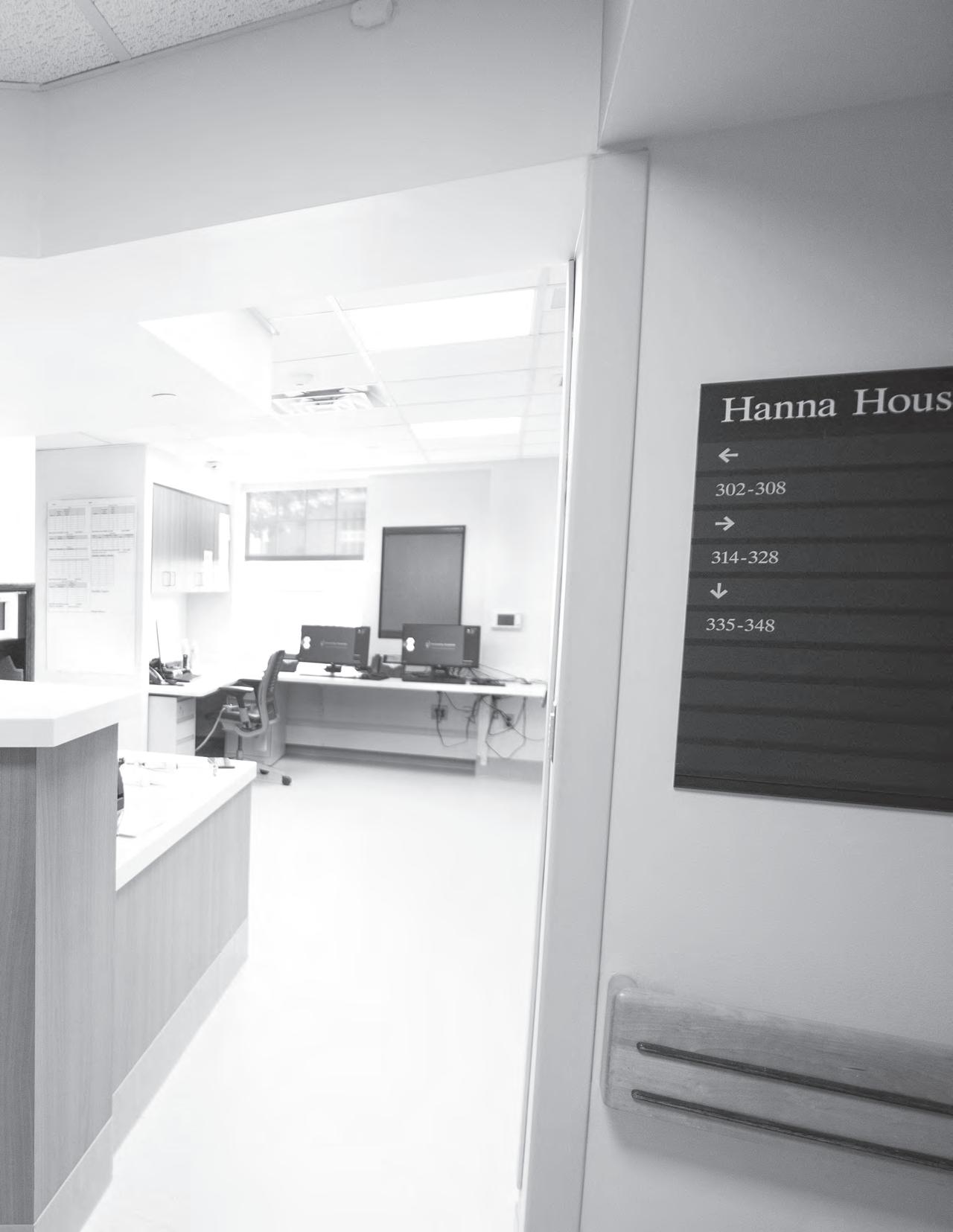
Pam says her board experience has increased her awareness of the need for equity – and an appreciation of both how UH and the May Dugan Center work toward that common strategy. Pam’s experience speaks to UH’s Community Health Improvement Strategy coming to life. As more caregivers continue to serve as board members, they may also naturally serve as champions of health equity within our organization to help socialize the importance of community benefit.

“That diversity makes us better able to consider all kinds of different factors in our decision-making and the board has tried really hard to ensure that it is reflective of the community, and that local residents have a say – it’s a great change, and it reflects changes in our culture.”

In the summer of 2021, children living in communities surrounding University Hospitals Cleveland Medical Center had a chance to immerse themselves in artistic expression that many adults would envy. The Center for Arts Inspired Learning had asked UH Rainbow Babies & Children’s Ahuja Center for Women & Children to brainstorm how they could collaborate to generate opportunities for kids to create art.
With grants from the Paul M. Angel Foundation and Jim and Maria Wymer, the idea of an art day camp for children was conceived.
That art day camp came to fruition as the UH Rainbow Creativity Camp and offered two twoweek block sessions at the historic Dunham Tavern Museum and grounds. Children from surrounding communities entering grades K-5 could attend.
Although advertised with flyers and signs throughout MidTown and by UH physicians, most Creativity Camp attendees were UH Rainbow patients and families.
Jennifer Walker, Manager of Injury Prevention, UH Rainbow Babies & Children’s Hospital, and Kathie Wesolowski, Director, Women’s and Children’s Community Outreach, worked with community artists to create the camp program.

“We hope to offer the Creativity Camp for kids in the community every year. It’s a fun, educational, and an inspiring experience for everyone involved,” said Kathie Wesolowski.
Camp Numbers:
38 children attended the camp – 13 for all four weeks
25 children attended one of the two-week sessions.
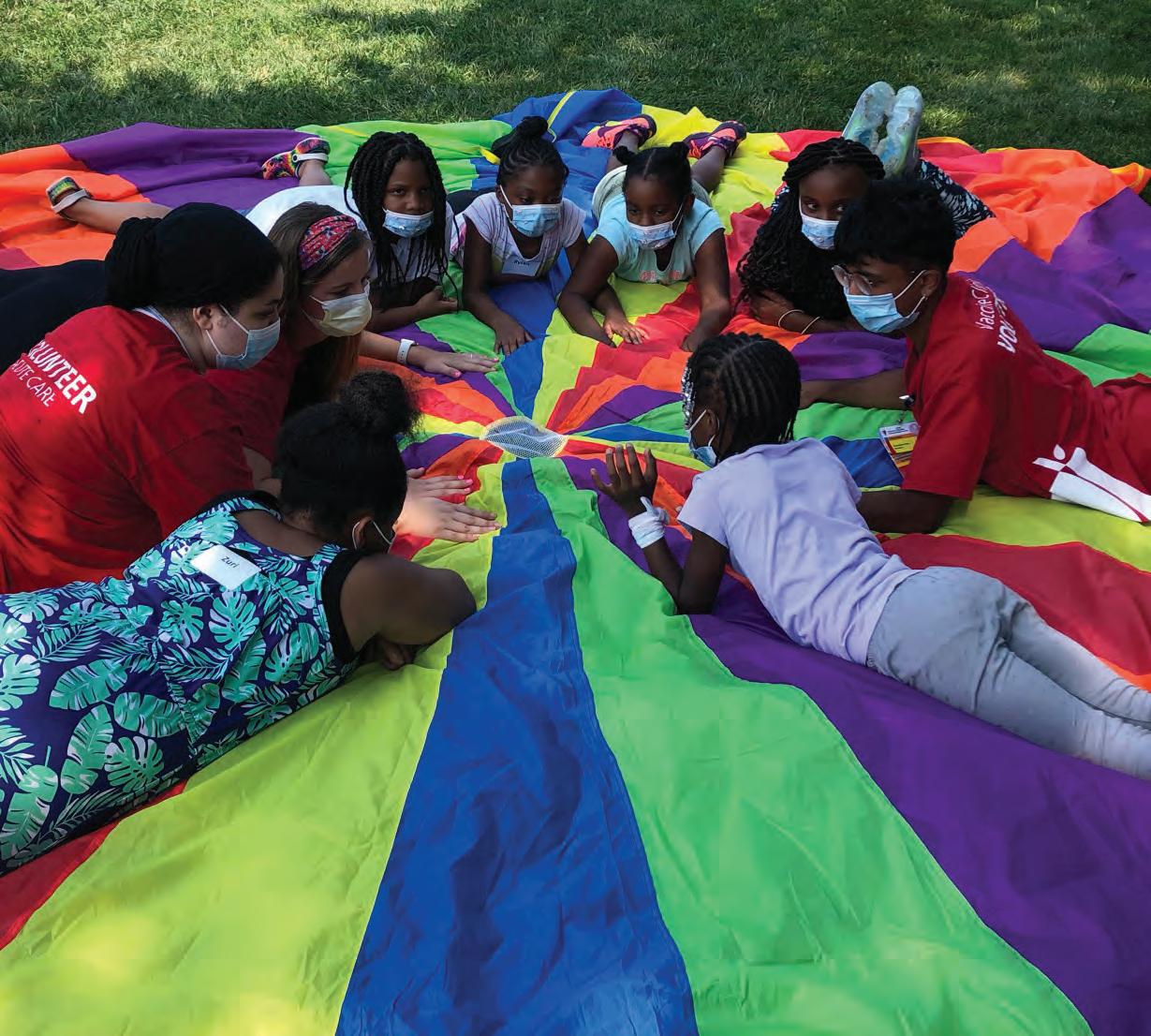
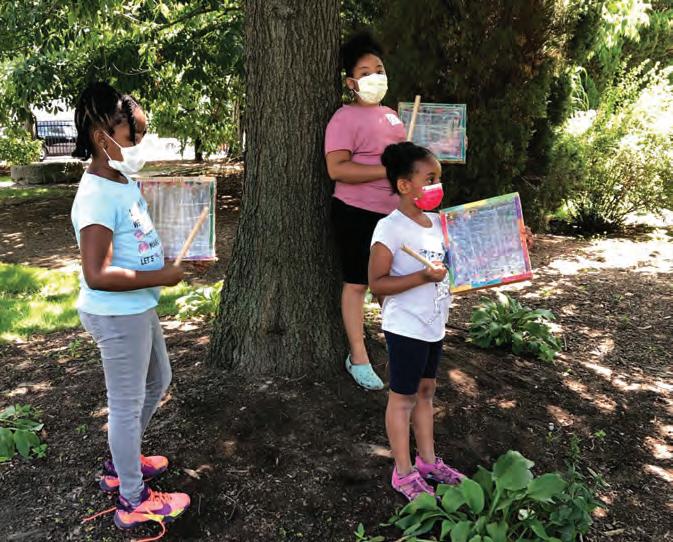
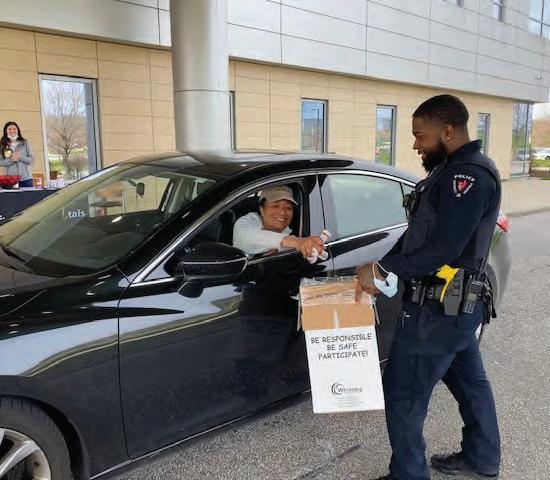
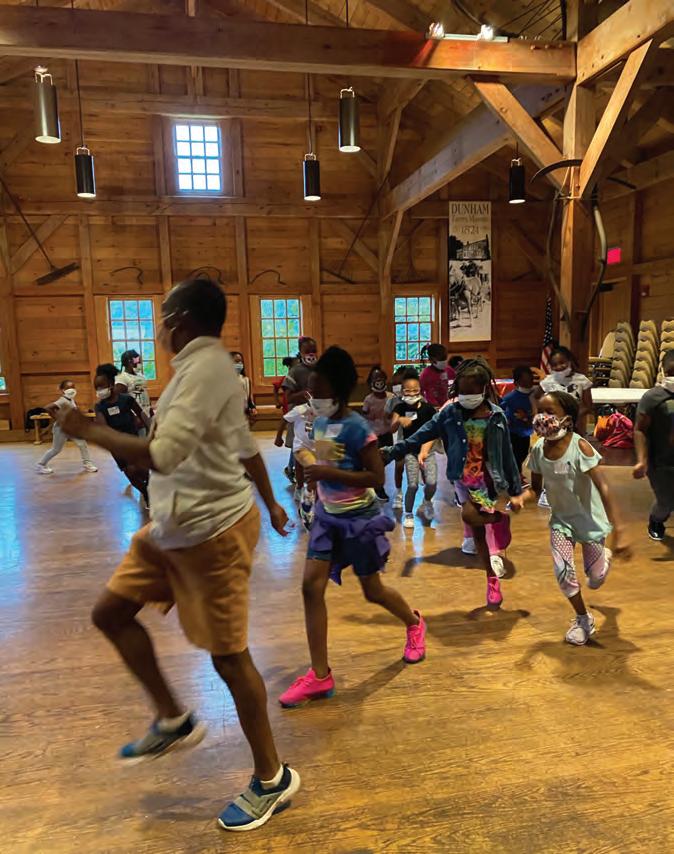
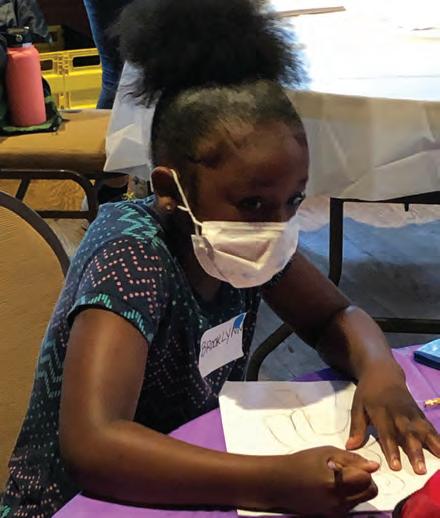
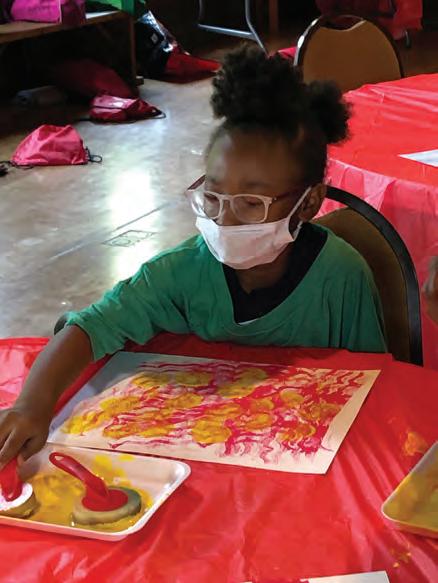


The United States is known around the world for having the highest cost for prescription medicine. Patients with good insurance may be able to manage those costs – for a time – but for lowincome patients, the situation can be dire from the start.
The 340B program was created 30 years ago as a safety net for low-income patients, with or without insurance, and other patients who would never be able to afford the medicines they need when they are ill, or suffering from a chronic condition.
The program’s name comes from Section 340B of the U.S. Public
Health Service Act of 1992. It requires pharmaceutical manufacturers that participate in Medicaid to sell outpatient drugs at discounted prices to health care organizations that care for many uninsured and low-income patients. The savings allows UH to benefit the community, to reach more eligible patients, and to provide more comprehensive care. The UH locations participating in 340B are UH Cleveland Medical Center, UH Rainbow Babies & Children’s Hospital, and UH Conneaut and UH Geneva medical centers.
At UH, a direct benefit to patients that stems from 340B is the pharmacy’s team-based approach. This includes
clinical pharmacists who are involved in the assessment of the patient, the evaluation of any therapeutic medication, the development and implementation of a medication management plan, and a collaboration with other UH Meds employees for any ongoing medication follow-up and needs.
The savings also allows UH to benefit the community by reaching more eligible patients and providing more comprehensive care, including pharmacist staff for services used by patients with such chronic illnesses as diabetic hypertension dyslipidemia, asthma and COPD.
Pat is one of those UH patients who is alive today in great part because of the 340B program. When she was first diagnosed with renal cell carcinoma at 50, she had surgery to remove her kidney. But over the years, cancer spread to other parts of her body, including her remaining kidney. Doctors prescribed Votrient, an oral chemotherapy drug, to shrink the tumor enough to allow the mass to be removed, while saving the kidney. It worked again when another tumor showed up. “It doesn’t cure the cancer, but it slows it down,” says Pat, who has been on a maintenance dose of the medication for the last four years.
When she approached retirement age, she and her husband worried about how they would afford the $12,000 per month price of Votrient. “When the doctor told me the cost, I was overwhelmed and so disheartened,” she said. “I thought, how will I stay on this medicine?”
That’s when her doctor referred her to the pharmacists and pharmacy technicians at UH Specialty Pharmacy, who provided Pat with, in her words, invaluable support, compassion and financial assistance. “My first concern was how to pay for my medications,” she says. “A very kind technician did some research and found a financial grant for which I was eligible and actually filled out all the online paperwork for me while we were on the phone.”
She was approved for the grant funding and today, the cost of her medication is paid for in part by Silver Scripts, a Part D Medicare program. The grant, which must be renewed every year, covers the balance.
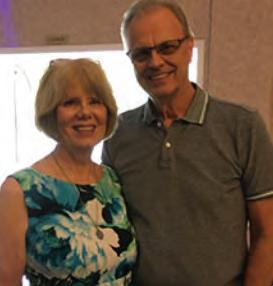
Ensuring diverse populations are represented in clinical trials means being proactive – and University Hospitals enhanced that effort when it launched its Mobile Research Unit in October 2021.

A customized 38-foot Winnebago was equipped with a range of medical equipment so it can travel to rural communities as well as to under-resourced neighborhoods where residents may not have a reliable form of transportation, which in itself is a barrier to clinical trial participation.
But it’s not just about logistics. “The mobile unit also will be used to educate people in Northeast Ohio about research trials, the need for diversity – and make the idea of participating in one far less intimidating,” says Grace McComsey, MD, Vice President of Research for UH, and the Rainbow Babies & Children's Foundation John Kennell Chair of Excellence in Pediatrics.
For a century or more, clinical research done throughout the U.S. was limited mainly to white men; eventually, women
began to be included. Communities of color continue to be vastly underrepresented.
And that means huge gaps in the knowledge behind the discoveries that lead to progress in care and treatment. Treatments being trialed, for example, may need to be tailored appropriately to meet our diverse population’s needs.
Just bringing more attention to clinical research, as the mobile unit does when it shows up outside of a Browns or Guardians game, is helpful. It travels to community hospitals and practices throughout the region, most of which lack research facilities, as well as to college campuses and nursing homes. It provides such services as flu shots to patients who are unable to leave their homes or care facilities.
John Dannug, a research and education integration specialist for the UH Clinical Research Center. “We also
“The Mobile Research Unit is the first in Northeast Ohio to bring research and discovery closer to home – literally,” says
educate people about research, so we will have resource tables at community events and online webinars for staff because we want that information to be accessible.”
As a major academic medical center, UH is dedicated to patient care and developing and approving new therapies for cancer, heart disease, infectious diseases, and many other specialties that require clinical research trials. It's crucial to expand the number and diversity of people who participate.

UH has approximately 4,300 active clinical research studies underway, but expanding the pool of volunteers to take part can be daunting, says Dr. McComsey. “People without transportation would not consider enrolling in research, when even getting to a doctor’s appointment presents an obstacle.” Taking the mobile unit to where patients live makes it far more likely that they enroll in a clinical trial – especially once they trust how important it is to determining different side effects or efficacy of a medicine, and learn details of the protocols and rigor involved in trials. Because of the level at which the bus is equipped, nearly 80 percent of the trials at UH can be done in the community.
The unit has
• Two private exam rooms


• Fully equipped for study procedures and assessments
• Laboratory processing center with a refrigerated centrifuge
• -80C freezer and refrigerator
• Investigational product refrigerators
• Freezers with continuous temperature monitoring
Additional features:
• Secure Wi-Fi
• Wheelchair lift
• Accessible restroom
Staffed with:
• Professional driver
• Room for two additional caregivers
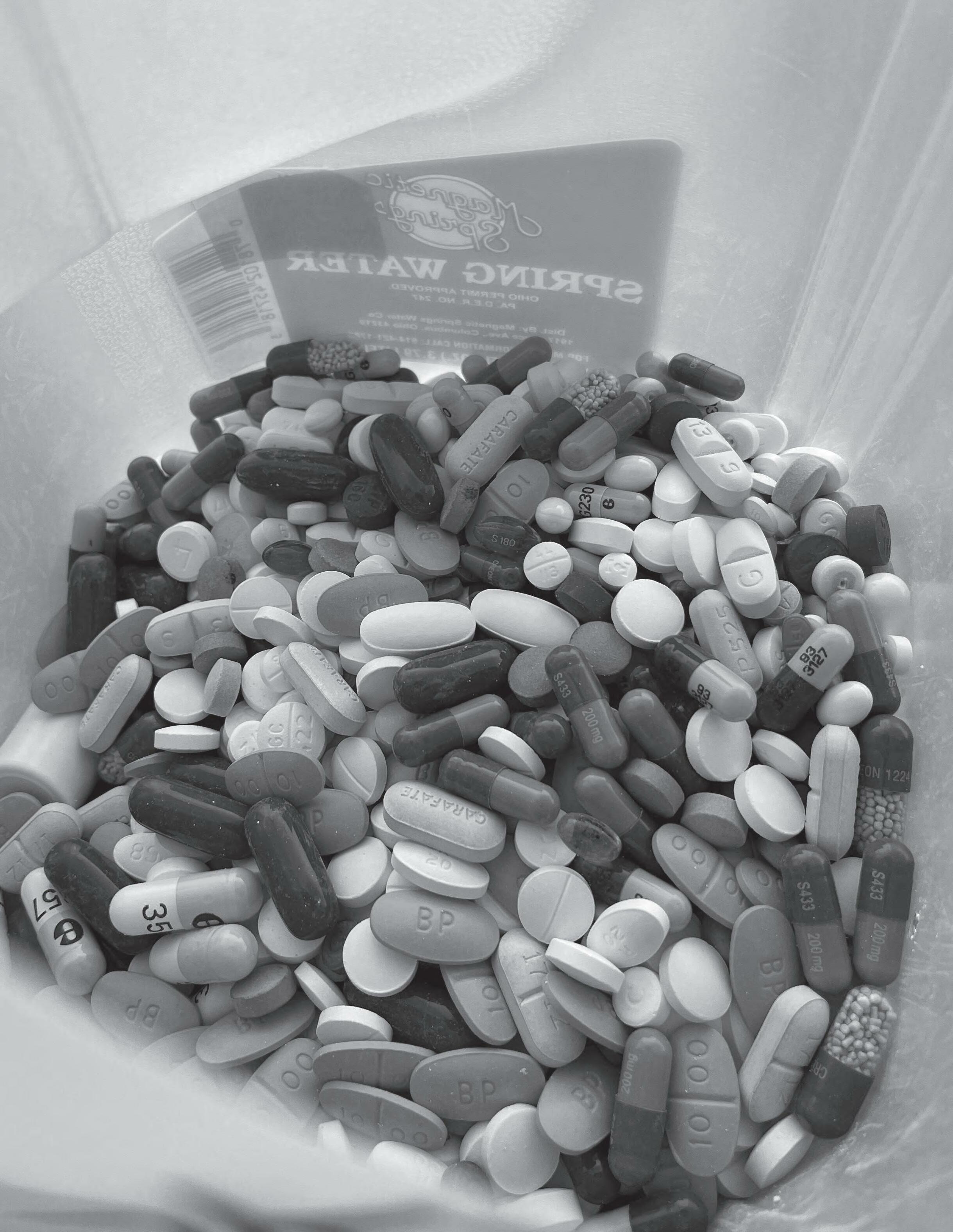


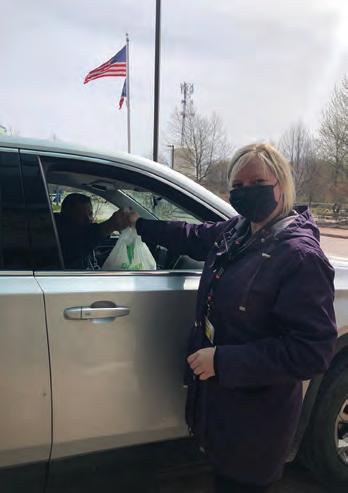
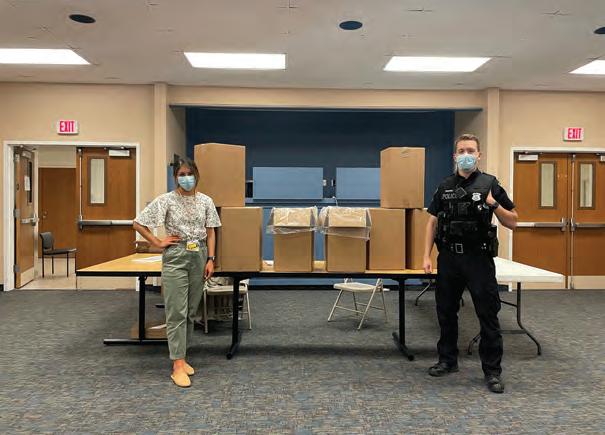
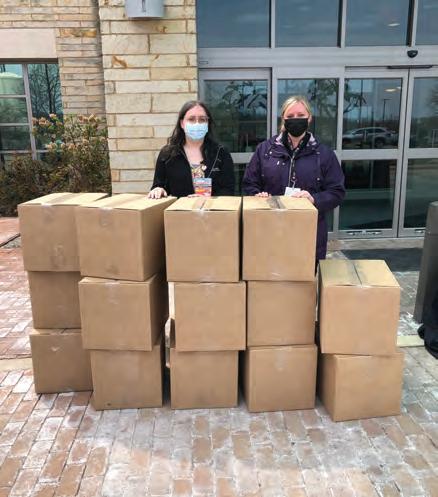
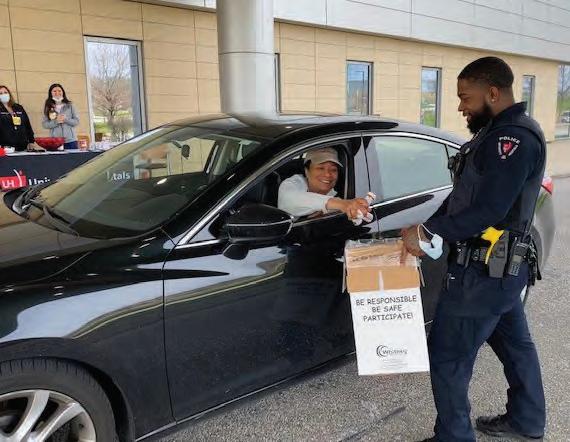
According to the National Survey on Drug Use and Health, the most misused prescriptions are most often obtained from family and friends, most frequently from home medicine cabinets.
This past spring, University Hospitals and Cleveland Clinic collaborated to organize a "Drug Take Back Day,” collecting medications at 17 sites across Northeast Ohio," including UH Ahuja and UH Portage medical centers.
This is designed to be a safe and convenient way to remove unused medications from the home, which can reduce the risk of accidental drug exposures as well as preventing drug misuse.
Disposal of prescription or over-thecounter drugs isn’t always easy for people to do. It’s not a good idea to throw drugs into the garbage, where someone in the home could still find them, and it’s a bad idea to flush them down the toilet, which can contaminate the water supply.
That’s why the Drug Enforcement Administration created National Prescription Drug Take Back Day, to raise awareness and give the public an easy way to rid their homes of potentially dangerous, expired, unused and unwanted prescriptions and over-thecounter drugs.
“Our partnership with colleagues at Cleveland Clinic demonstrates our commitment to addressing this serious public health issue,” says Jeanne Lackamp, MD, Director of the UH Pain Management Institute. “Inappropriate use of medications that many people may have in their homes – both opioids and non-opioids – can lead to dire consequences and even death.
“Our participation in activities such as National Prescription Drug Take Back Day directly helps get unused drugs out of our homes and off our streets, and helps keep our patients and our communities safer.”
Throughout the U.S., substance misuse and unintentional overdoses remain a deadly problem. Last year, Cuyahoga County alone had 700 opioid overdose deaths.
Of the nine Northeast Ohio counties, Lorain, Lake and Cuyahoga counties ranked in the top three for the number of overdose deaths between 2018 and 2020.
Sam
Calabrese, Chief Pharmacy Officer at Cleveland Clinic, concurs.“We are proud to be working with University Hospitals on a variety of initiatives to control the opioid epidemic in our communities. Collaboration makes us stronger and benefits the health of our communities,” he said.
UH also offers year-round disposal locations at its pharmacies:
• Bolwell Pharmacy at UH Cleveland Medical Center
• UH Rainbow Babies & Children's Hospital
• UH Rainbow Babies & Children's Ahuja Center for Women & Children
• UH Mentor Hopkins Health Center
• UH Minoff Health Center at Chagrin Highlands
• UH Geauga Medical Center
• UH Westlake Health Center
• UH Elyria Gates Medical Building
• UH Portage Medical Center
“Providing the public with a safe and convenient way to remove unused medications from the home is an important step in reducing the risk of accidental drug exposure as well as preventing drug misuse.”
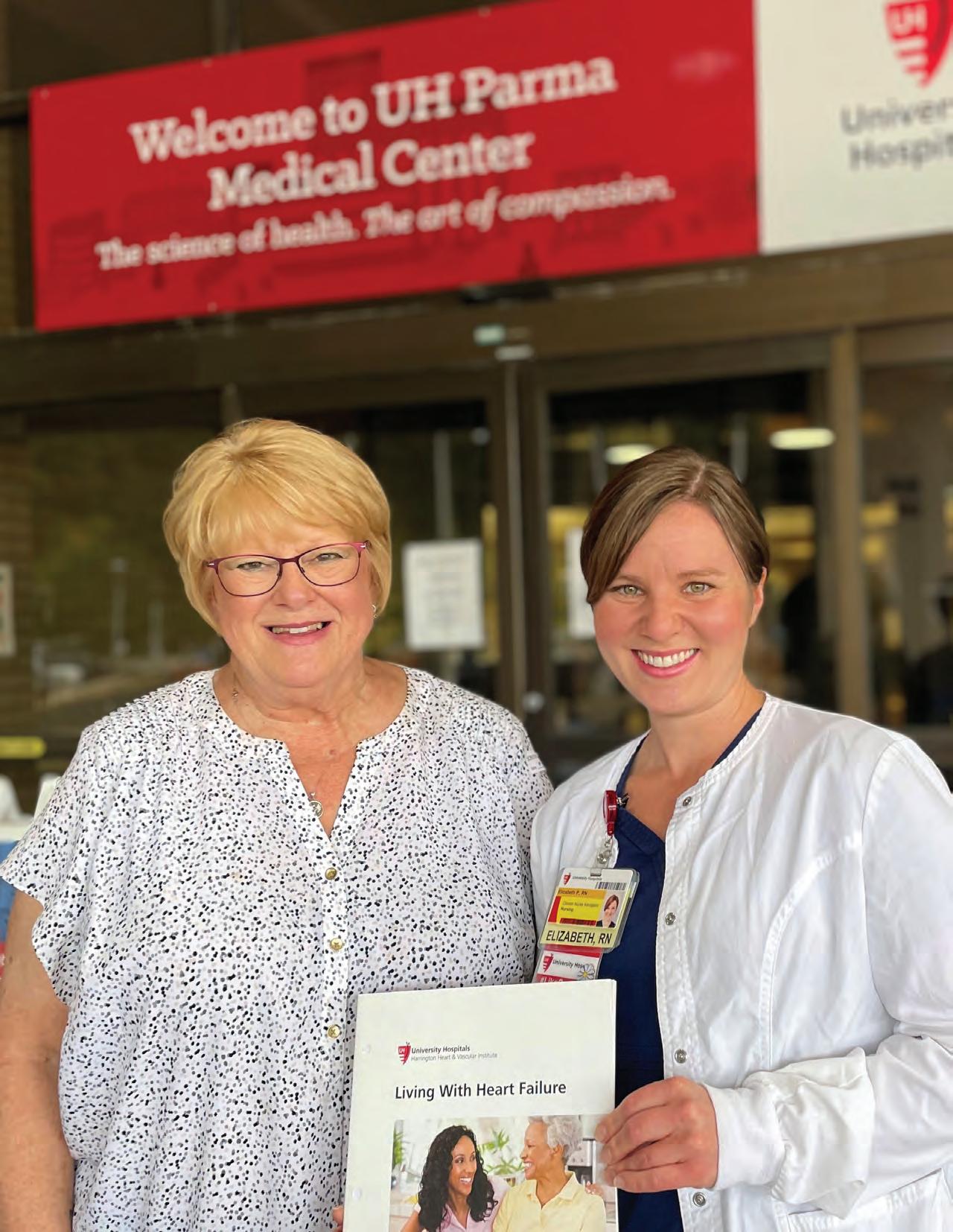
Many people are first introduced to UH from its medical centers’ Community Outreach efforts. What kind of outreach is done is based on the community’s needs, whether it is health education, screenings or other offerings. These stories show the breadth and variety of that outreach.
Being a patient living with a serous chronic illness can be not only lonely, but can affect how long you live.

That’s why University Hospitals Parma Medical Center has nurse navigators for patients, one for those living with chronic obstructive pulmonary disease (COPD), another for patients with congestive heart failure. Neither condition can be cured, but they can be managed –effectively or not so effectively, it turns out.
Christopher Dussel, MD, is the Chief Medical Officer of UH Parma Medical Center. When physicians and nurse quality experts were looking to understand the reasons behinds elevated hospital re-admissions, COPD was clearly a condition that led to this. All too often, patients were heading to the Emergency Department (ED) and then admitted.
“They were frightened and distressed from having a very hard time breathing, so they’d go to the ED,” says Dr. Dussel, who is also a practicing ED physician. “We wanted to know what we could do to stop this cycle, and get to the bottom of why the disease isn’t managed as well as it could be.”
So patients were connected to a respiratory therapist who could help them get the therapy they needed, assist them with a medication change, or perhaps help them learn to eat a healthier diet.
Sometimes the solution was startling –one patient attributed her suffering to her inhaler no longer being effective at improving her breathing. The respiratory therapist (RT) asked to check out the package the inhaler had come in. It turns out the vial that contained the medication had been taped to the bottom of the package and was not already inside the inhaler, as the patient had thought.
“Our team looked comprehensively at the entire process, from admission to discharge to readmission, with an emphasis on what occurs after the patient leaves the hospital,” Dr. Dussel says, noting that education is the key to controlling the disease after the patient goes home. One patient, who felt so much better after the interventions of the Pulmonary
Navigator stated, “I know I’m not going to be cured, but I feel so much better that now I can go to breakfast with my friends and enjoy my life.”
Congestive heart failure is another condition in which effective management makes a huge difference to a patient’s life. “Sometimes a patient needs to have their medication changed, or something else is not working,” he says. “Maybe they need to monitor their salt intake more closely. The navigator will teach them to check their weight daily and if they gain three or four pounds in a day, chances are they are retaining fluid – a classic symptom of heart failure. The Heart Failure Nurse Navigator teaches them to adjust their sodium intake and make other adjustments to address the problem and avoid hospitalization.”
Patients were also provided with more resources, including books on how to follow a heart-healthy diet, a scale with which to monitor their weight, or referrals for other clinical interventions. “Having the navigators has resulted in a marked drop in readmission rates, and, most importantly, increased life quality for our patients and their families,” says Dr. Dussel.
“It’s really a very concentrated effort to help the sickest patients,” Dr. Dussel says. “The work of our navigators extends well beyond the walls of the hospital into the community.”

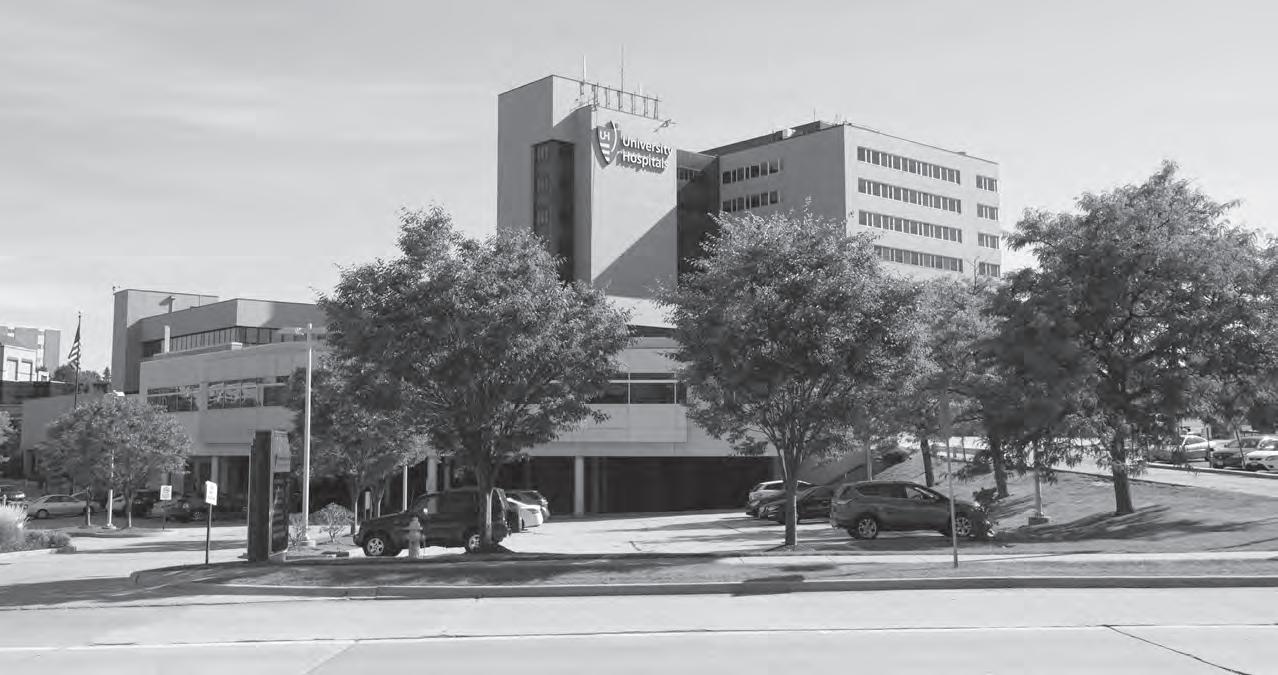
As the challenges of COVD-19 continued in 2021, UH Conneaut and Geneva medical centers' Community Outreach team members continued to adapt their approach to meet the needs of this fluid situation. Here is some of what each of them did:
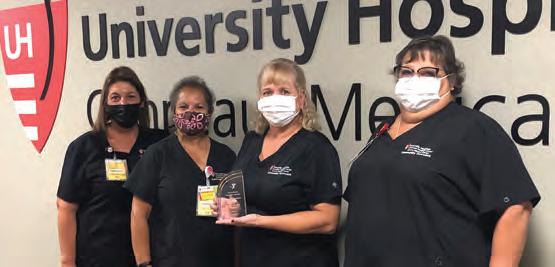
Kellie McGinnis, a UH caregiver and one of the team members, coordinated the UH Conneaut and Geneva teams for the Ashtabula County Feed the Hope event, where 300,000 meals were packed in two hours for 19 local food pantries.
When the annual Walk for the Cure was cancelled three weeks before the scheduled event, Paula Covell quickly came up with new ways to raise funds for the free mammogram program offered to underserved women in Ashtabula County and eastern Lake County. Recipe books, made with UH caregiver recipes, and basket raffles were held at both facilities and a Volley for the Cure event was held at Geneva High School. These efforts raised $13,000 for the program.
Paula also assisted with Neurology telemedicine visits that allowed patients to see a specialist closer to home.
Lori Slimmer shifted her traditional methods for the Diabetes Self-Management and Education program by switching to phone, Zoom or email to connect with patients and community members.
She also developed community health education materials shared via UH Conneaut and UH Geneva Facebook pages, and in email blasts to more than 1,000 community residents. This allowed them to receive health education at home on such topics as stroke, hernia, heat exhaustion or heat stroke, dehydration, depression and breast health, among others.
At the Ashtabula County Family YMCA annual dinner, UH Conneaut and Geneva Community Outreach team members were honored to receive the Community Partner Award in recognition of the many events conducted to provide health resources and education to the community.
Team member Christin Houghton further developed the Hospital to Home program with a new Bedside Education option for patients who are admitted with such diagnoses as
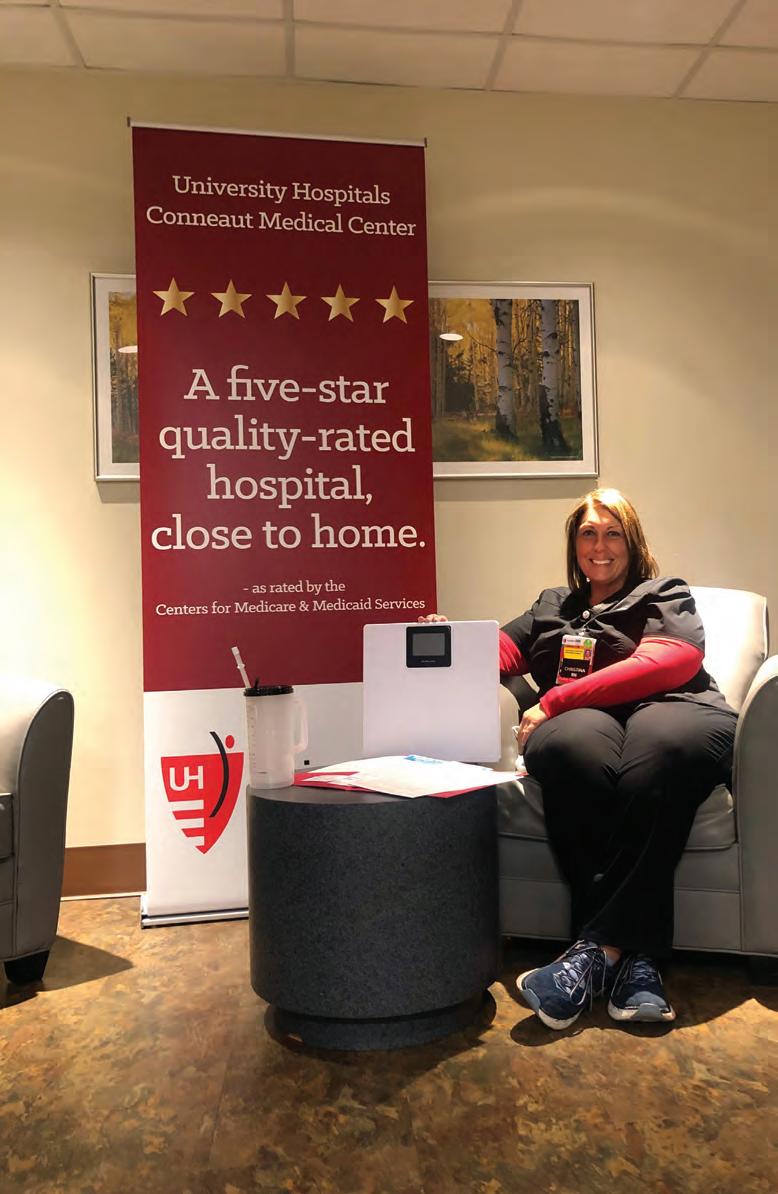 Hospital to Home
YMCA Community Partner Award
Hospital to Home
YMCA Community Partner Award
Some 16 percent of Lake County residents report having type 2 diabetes, and many thousands more are pre-diabetic. Diabetes is also one of the largest public health concerns in the country.
So the Diabetes Education Teams at University Hospitals TriPoint and Lake West medical centers are making an invaluable contribution to the prevention of that condition with the Prevent T2 program
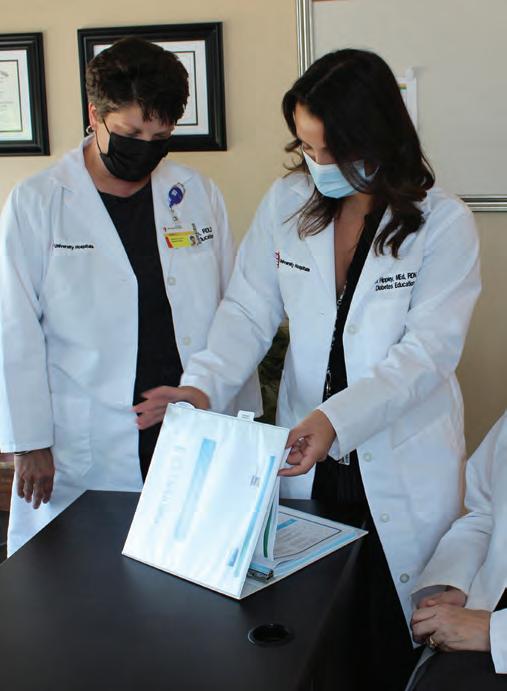
Through Prevent T2, a Centers for Disease Control and Prevention (CDC)-recognized lifestyle change program, patients with prediabetes work with certified diabetes educators, and other health professionals, to learn how to make modest changes to prevent type 2 diabetes and perhaps even reverse their prediabetes condition by making healthy diet and physical activity changes.
According to the CDC, more than 37.3 million Americans have diabetes, and that number is expected to increase as 96 million American adults, more than one in three, have prediabetes.
Prediabetes puts you at increased risk of developing type 2 diabetes, but shockingly, of those with prediabetes, more than 80 percent don’t even know they have it. When it is uncontrolled, diabetes can lead to other health conditions such as heart disease; stroke; kidney failure; vision loss; amputation of toes, feet or legs; and premature death.
According to Kellie Slusher, BSN, MSN, PCMH CCE, ACO Manager, Clinical Integration Technology and Network Operations and Manager, Diabetes Education Services for UH TriPoint and Lake West medical centers, two cohort groups have completed Prevent T2 since the program started in January 2020.
The first group of eight participants lost a total of 137 pounds and increased their physical activity by 773 minutes per week. The second group of nine participants lost a total of 135 pounds and increased their physical activity by 1,050 minutes per week.
As a result of this success of the Prevent T2 program, UH TriPoint and LakeWest medical centers were officially recognized by the CDC as a National Diabetes Prevention Program. This program was created in 2010 to address the increasing burden of prediabetes and type 2 diabetes in the U.S.

Research has shown that people with prediabetes who take part in a structured lifestyle change program that focuses on healthy eating and physical activity can cut their risk of developing type 2 diabetes by 58 percent, says Slusher.
For those who have diabetes, the Diabetes Education Team helps them manage their condition with expert
treatment and education. One of the methods is through the Continuous Glucose Monitoring (CGM) Program, which currently has more than 100 patients enrolled.

A CGM measures the body’s glucose (sugar) levels in realtime by sensing the glucose present in tissue fluid. It can be used for patients with both type 1 and type 2 diabetes and provides a constant stream of information on glucose levels, trends and overnight data. Through the program, patients are able to try the CGM for free and work with physicians to monitor their blood sugar readings.
The Diabetes Education Team also hosts a free diabetes education program open to the community that consists of four two-hour classes focusing on the basics of diabetes, eating healthy and fitting your favorite foods into your new lifestyle, maintaining glycemic targets, medications, how to delay or prevent complications from diabetes, how to do long-term planning and more, as well as a diabetes virtual support group.
In 2015, the community outreach team at University Hospitals Portage Medical Center began collaborating with the Windham Library on a summer program.
The library, which is at the Renaissance Family Center in the village of Windham, had a summer garden club, and the librarian asked if the team at UH Portage could provide nutrition education to the group. There were already a few raised beds in the Renaissance Center courtyard where tomatoes and herbs were grown.
So of course, the answer was ‘yes.’
Windham faces a number of social and economic challenges, as well as a lack of grocery stores and availability of fresh produce. Now the gardens are just one part – but an important one – that fits into the community health priorities for the UH Portage outreach team. The lack of healthful food options in and around the Windham community plays a part in residents developing chronic diseases such as diabetes and heart disease.
The outreach team has developed a sustainable plan to maintain the garden to ensure we can educate community members and families on gardening and healthy eating. Also offered are blood pressure screenings and access to care resources to encourage residents to connect with a primary care provider to manage their health and wellness.
By 2017, UH Portage had developed a partnership with the Portage County Extension Office Master Gardener program to expand the Renaissance Family Center courtyard’s gardens. Gardeners volunteer their time to provide educational services to their communities.

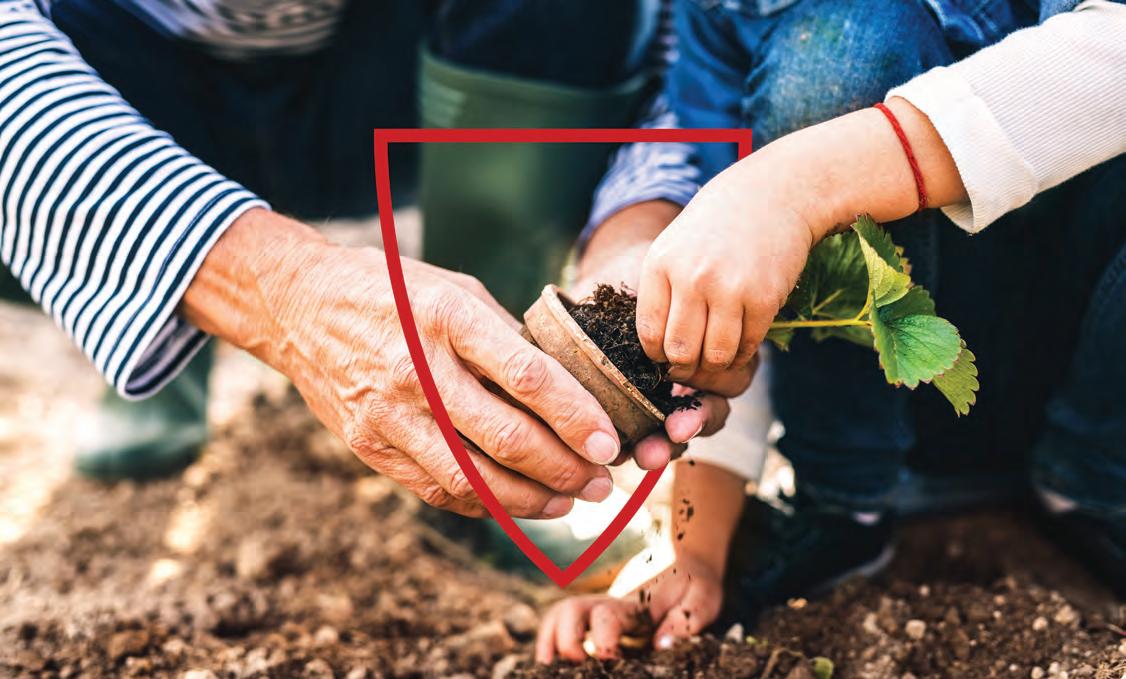
That includes answering gardening questions from the public, conducting plant clinics and gardening activities for children, senior citizens, or disabled people, beautifying the community, and developing community or demonstration gardens.
In 2018, the planning of a community garden got a big boost from a $30,000 grant from AMETEK Inc., in Kent. The expanded garden beds and infrastructure were developed, as was an accessible path to the beds. Seasonal planting began, and in 2019 the garden was named the AMETEK Food Forest
Gardeners and volunteers – including from the UH Portage outreach team – planted strawberries, raspberries, grapes, tomatoes, peppers and other produce.
Now, two-plus years later, there’s also a relationship with the Kent State University College of Public Health. With help from a program intern, the outreach team developed a garden club curriculum which was being taught in Kent. Connecting with the university was an opportunity to increase community awareness of the garden.
An elementary school adjacent to AMETEK Food Forest was identified as a great location for the garden club, which would provide information and education as well as access to the garden. In fall 2021, a kindergarten garden club was created at Katherine Thomas Elementary and this spring, seedlings were planted for a ‘salsa garden,’ which grows the vegetables –including tomatoes – used to make salsa.
The seedlings were nurtured by the school librarian who, on the last day of school in May, helped the kindergarteners plant their tomatoes, peppers, herbs, and onions.


Last year more than 60 lbs. of strawberries were distributed to the community, while more than 100 lbs. will be distributed this year. Now, fresh produce is far more available in a community where it is not easy to find in stores, and residents have shared their appreciation for that.
